The Effect Of Intraoperative Dexmedetomidine Promotes On Postoperative Analgesia And Recovery In Patients Undergoing To General Anaesthesia
VerifiedAdded on 2023/06/15
|17
|6319
|287
AI Summary
This review evaluates the effects of dexmedetomidine usage in postoperative care process on promotion of post analgesic recovery among patients undergoing treatment. The study aims at evaluating dexmedetomidine during operation and its reduction process compared to other opioid drugs such as narcotic due to its association to side effects.
Contribute Materials
Your contribution can guide someone’s learning journey. Share your
documents today.
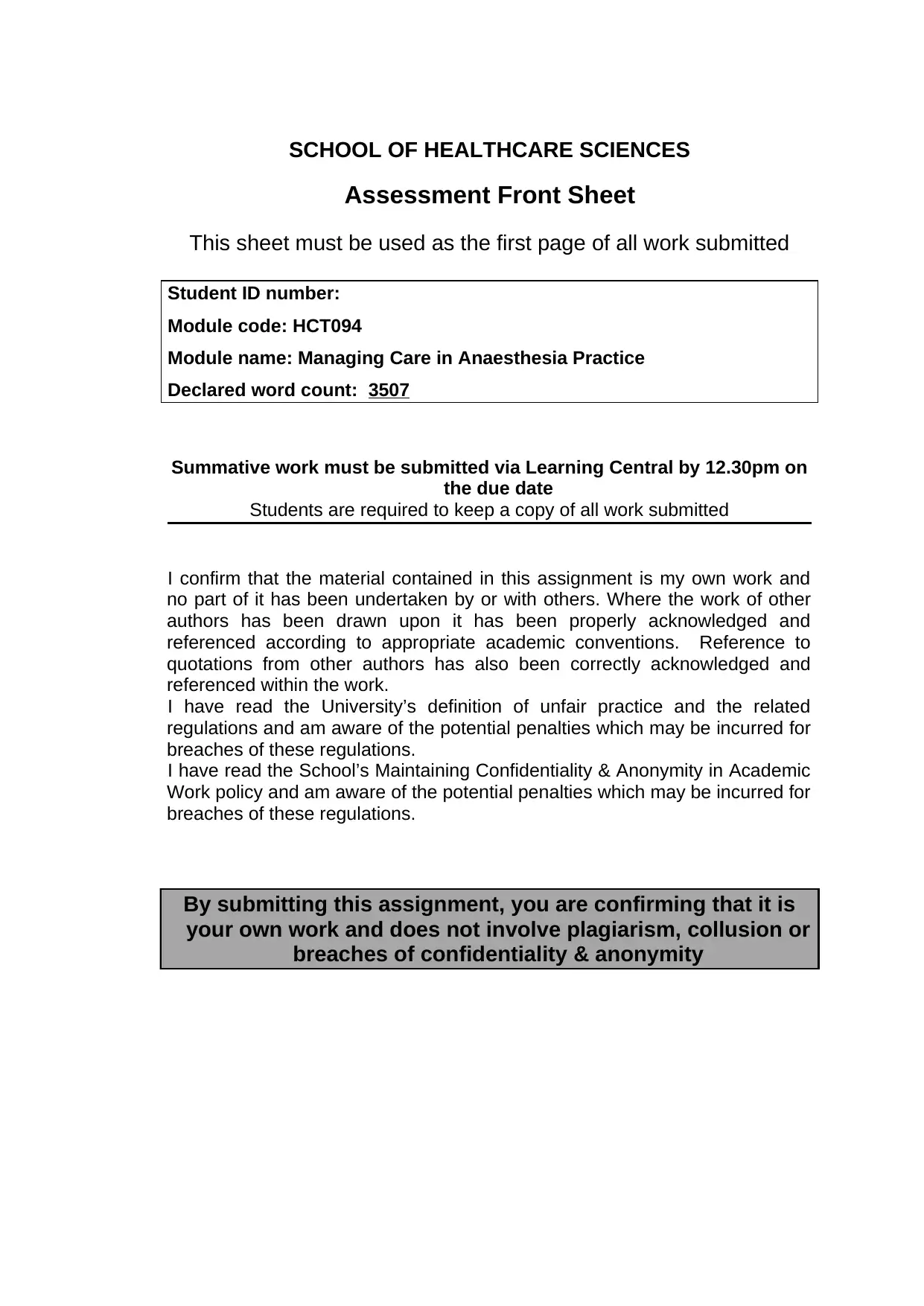
SCHOOL OF HEALTHCARE SCIENCES
Assessment Front Sheet
This sheet must be used as the first page of all work submitted
Student ID number:
Module code: HCT094
Module name: Managing Care in Anaesthesia Practice
Declared word count: 3507
Summative work must be submitted via Learning Central by 12.30pm on
the due date
Students are required to keep a copy of all work submitted
I confirm that the material contained in this assignment is my own work and
no part of it has been undertaken by or with others. Where the work of other
authors has been drawn upon it has been properly acknowledged and
referenced according to appropriate academic conventions. Reference to
quotations from other authors has also been correctly acknowledged and
referenced within the work.
I have read the University’s definition of unfair practice and the related
regulations and am aware of the potential penalties which may be incurred for
breaches of these regulations.
I have read the School’s Maintaining Confidentiality & Anonymity in Academic
Work policy and am aware of the potential penalties which may be incurred for
breaches of these regulations.
By submitting this assignment, you are confirming that it is
your own work and does not involve plagiarism, collusion or
breaches of confidentiality & anonymity
Assessment Front Sheet
This sheet must be used as the first page of all work submitted
Student ID number:
Module code: HCT094
Module name: Managing Care in Anaesthesia Practice
Declared word count: 3507
Summative work must be submitted via Learning Central by 12.30pm on
the due date
Students are required to keep a copy of all work submitted
I confirm that the material contained in this assignment is my own work and
no part of it has been undertaken by or with others. Where the work of other
authors has been drawn upon it has been properly acknowledged and
referenced according to appropriate academic conventions. Reference to
quotations from other authors has also been correctly acknowledged and
referenced within the work.
I have read the University’s definition of unfair practice and the related
regulations and am aware of the potential penalties which may be incurred for
breaches of these regulations.
I have read the School’s Maintaining Confidentiality & Anonymity in Academic
Work policy and am aware of the potential penalties which may be incurred for
breaches of these regulations.
By submitting this assignment, you are confirming that it is
your own work and does not involve plagiarism, collusion or
breaches of confidentiality & anonymity
Secure Best Marks with AI Grader
Need help grading? Try our AI Grader for instant feedback on your assignments.

2
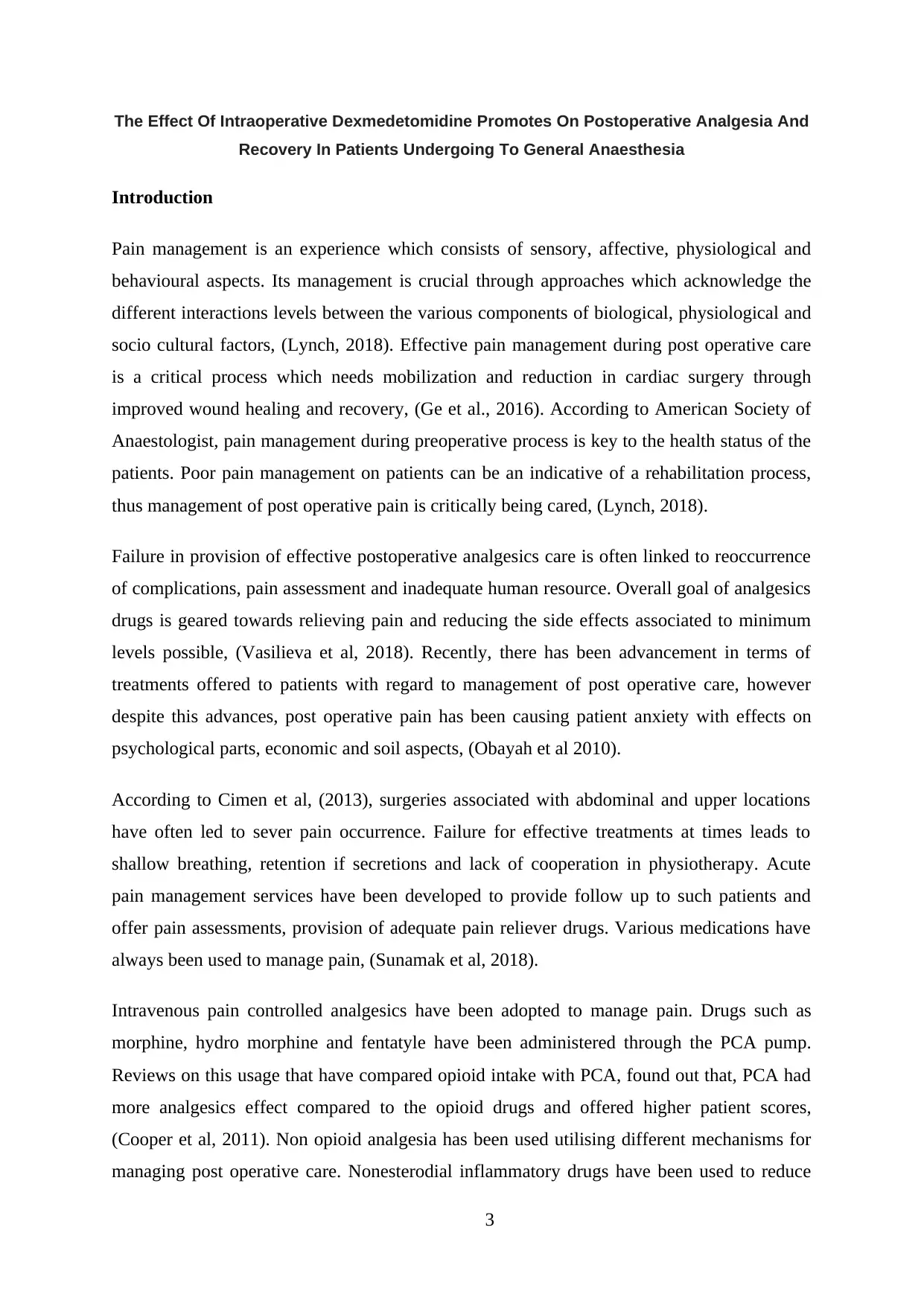
The Effect Of Intraoperative Dexmedetomidine Promotes On Postoperative Analgesia And
Recovery In Patients Undergoing To General Anaesthesia
Introduction
Pain management is an experience which consists of sensory, affective, physiological and
behavioural aspects. Its management is crucial through approaches which acknowledge the
different interactions levels between the various components of biological, physiological and
socio cultural factors, (Lynch, 2018). Effective pain management during post operative care
is a critical process which needs mobilization and reduction in cardiac surgery through
improved wound healing and recovery, (Ge et al., 2016). According to American Society of
Anaestologist, pain management during preoperative process is key to the health status of the
patients. Poor pain management on patients can be an indicative of a rehabilitation process,
thus management of post operative pain is critically being cared, (Lynch, 2018).
Failure in provision of effective postoperative analgesics care is often linked to reoccurrence
of complications, pain assessment and inadequate human resource. Overall goal of analgesics
drugs is geared towards relieving pain and reducing the side effects associated to minimum
levels possible, (Vasilieva et al, 2018). Recently, there has been advancement in terms of
treatments offered to patients with regard to management of post operative care, however
despite this advances, post operative pain has been causing patient anxiety with effects on
psychological parts, economic and soil aspects, (Obayah et al 2010).
According to Cimen et al, (2013), surgeries associated with abdominal and upper locations
have often led to sever pain occurrence. Failure for effective treatments at times leads to
shallow breathing, retention if secretions and lack of cooperation in physiotherapy. Acute
pain management services have been developed to provide follow up to such patients and
offer pain assessments, provision of adequate pain reliever drugs. Various medications have
always been used to manage pain, (Sunamak et al, 2018).
Intravenous pain controlled analgesics have been adopted to manage pain. Drugs such as
morphine, hydro morphine and fentatyle have been administered through the PCA pump.
Reviews on this usage that have compared opioid intake with PCA, found out that, PCA had
more analgesics effect compared to the opioid drugs and offered higher patient scores,
(Cooper et al, 2011). Non opioid analgesia has been used utilising different mechanisms for
managing post operative care. Nonesterodial inflammatory drugs have been used to reduce
3
Recovery In Patients Undergoing To General Anaesthesia
Introduction
Pain management is an experience which consists of sensory, affective, physiological and
behavioural aspects. Its management is crucial through approaches which acknowledge the
different interactions levels between the various components of biological, physiological and
socio cultural factors, (Lynch, 2018). Effective pain management during post operative care
is a critical process which needs mobilization and reduction in cardiac surgery through
improved wound healing and recovery, (Ge et al., 2016). According to American Society of
Anaestologist, pain management during preoperative process is key to the health status of the
patients. Poor pain management on patients can be an indicative of a rehabilitation process,
thus management of post operative pain is critically being cared, (Lynch, 2018).
Failure in provision of effective postoperative analgesics care is often linked to reoccurrence
of complications, pain assessment and inadequate human resource. Overall goal of analgesics
drugs is geared towards relieving pain and reducing the side effects associated to minimum
levels possible, (Vasilieva et al, 2018). Recently, there has been advancement in terms of
treatments offered to patients with regard to management of post operative care, however
despite this advances, post operative pain has been causing patient anxiety with effects on
psychological parts, economic and soil aspects, (Obayah et al 2010).
According to Cimen et al, (2013), surgeries associated with abdominal and upper locations
have often led to sever pain occurrence. Failure for effective treatments at times leads to
shallow breathing, retention if secretions and lack of cooperation in physiotherapy. Acute
pain management services have been developed to provide follow up to such patients and
offer pain assessments, provision of adequate pain reliever drugs. Various medications have
always been used to manage pain, (Sunamak et al, 2018).
Intravenous pain controlled analgesics have been adopted to manage pain. Drugs such as
morphine, hydro morphine and fentatyle have been administered through the PCA pump.
Reviews on this usage that have compared opioid intake with PCA, found out that, PCA had
more analgesics effect compared to the opioid drugs and offered higher patient scores,
(Cooper et al, 2011). Non opioid analgesia has been used utilising different mechanisms for
managing post operative care. Nonesterodial inflammatory drugs have been used to reduce
3
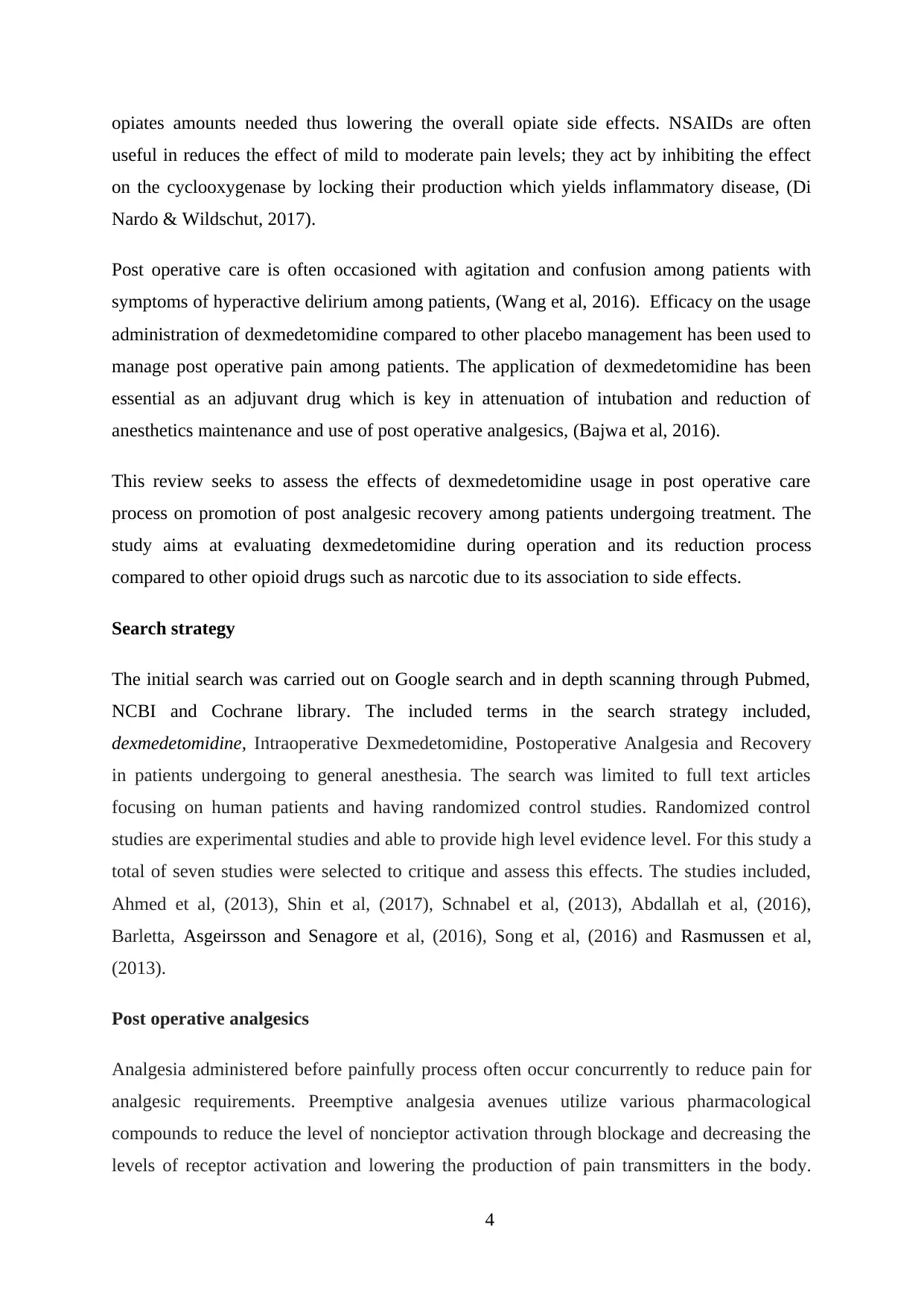
opiates amounts needed thus lowering the overall opiate side effects. NSAIDs are often
useful in reduces the effect of mild to moderate pain levels; they act by inhibiting the effect
on the cyclooxygenase by locking their production which yields inflammatory disease, (Di
Nardo & Wildschut, 2017).
Post operative care is often occasioned with agitation and confusion among patients with
symptoms of hyperactive delirium among patients, (Wang et al, 2016). Efficacy on the usage
administration of dexmedetomidine compared to other placebo management has been used to
manage post operative pain among patients. The application of dexmedetomidine has been
essential as an adjuvant drug which is key in attenuation of intubation and reduction of
anesthetics maintenance and use of post operative analgesics, (Bajwa et al, 2016).
This review seeks to assess the effects of dexmedetomidine usage in post operative care
process on promotion of post analgesic recovery among patients undergoing treatment. The
study aims at evaluating dexmedetomidine during operation and its reduction process
compared to other opioid drugs such as narcotic due to its association to side effects.
Search strategy
The initial search was carried out on Google search and in depth scanning through Pubmed,
NCBI and Cochrane library. The included terms in the search strategy included,
dexmedetomidine, Intraoperative Dexmedetomidine, Postoperative Analgesia and Recovery
in patients undergoing to general anesthesia. The search was limited to full text articles
focusing on human patients and having randomized control studies. Randomized control
studies are experimental studies and able to provide high level evidence level. For this study a
total of seven studies were selected to critique and assess this effects. The studies included,
Ahmed et al, (2013), Shin et al, (2017), Schnabel et al, (2013), Abdallah et al, (2016),
Barletta, Asgeirsson and Senagore et al, (2016), Song et al, (2016) and Rasmussen et al,
(2013).
Post operative analgesics
Analgesia administered before painfully process often occur concurrently to reduce pain for
analgesic requirements. Preemptive analgesia avenues utilize various pharmacological
compounds to reduce the level of noncieptor activation through blockage and decreasing the
levels of receptor activation and lowering the production of pain transmitters in the body.
4
useful in reduces the effect of mild to moderate pain levels; they act by inhibiting the effect
on the cyclooxygenase by locking their production which yields inflammatory disease, (Di
Nardo & Wildschut, 2017).
Post operative care is often occasioned with agitation and confusion among patients with
symptoms of hyperactive delirium among patients, (Wang et al, 2016). Efficacy on the usage
administration of dexmedetomidine compared to other placebo management has been used to
manage post operative pain among patients. The application of dexmedetomidine has been
essential as an adjuvant drug which is key in attenuation of intubation and reduction of
anesthetics maintenance and use of post operative analgesics, (Bajwa et al, 2016).
This review seeks to assess the effects of dexmedetomidine usage in post operative care
process on promotion of post analgesic recovery among patients undergoing treatment. The
study aims at evaluating dexmedetomidine during operation and its reduction process
compared to other opioid drugs such as narcotic due to its association to side effects.
Search strategy
The initial search was carried out on Google search and in depth scanning through Pubmed,
NCBI and Cochrane library. The included terms in the search strategy included,
dexmedetomidine, Intraoperative Dexmedetomidine, Postoperative Analgesia and Recovery
in patients undergoing to general anesthesia. The search was limited to full text articles
focusing on human patients and having randomized control studies. Randomized control
studies are experimental studies and able to provide high level evidence level. For this study a
total of seven studies were selected to critique and assess this effects. The studies included,
Ahmed et al, (2013), Shin et al, (2017), Schnabel et al, (2013), Abdallah et al, (2016),
Barletta, Asgeirsson and Senagore et al, (2016), Song et al, (2016) and Rasmussen et al,
(2013).
Post operative analgesics
Analgesia administered before painfully process often occur concurrently to reduce pain for
analgesic requirements. Preemptive analgesia avenues utilize various pharmacological
compounds to reduce the level of noncieptor activation through blockage and decreasing the
levels of receptor activation and lowering the production of pain transmitters in the body.
4
Secure Best Marks with AI Grader
Need help grading? Try our AI Grader for instant feedback on your assignments.
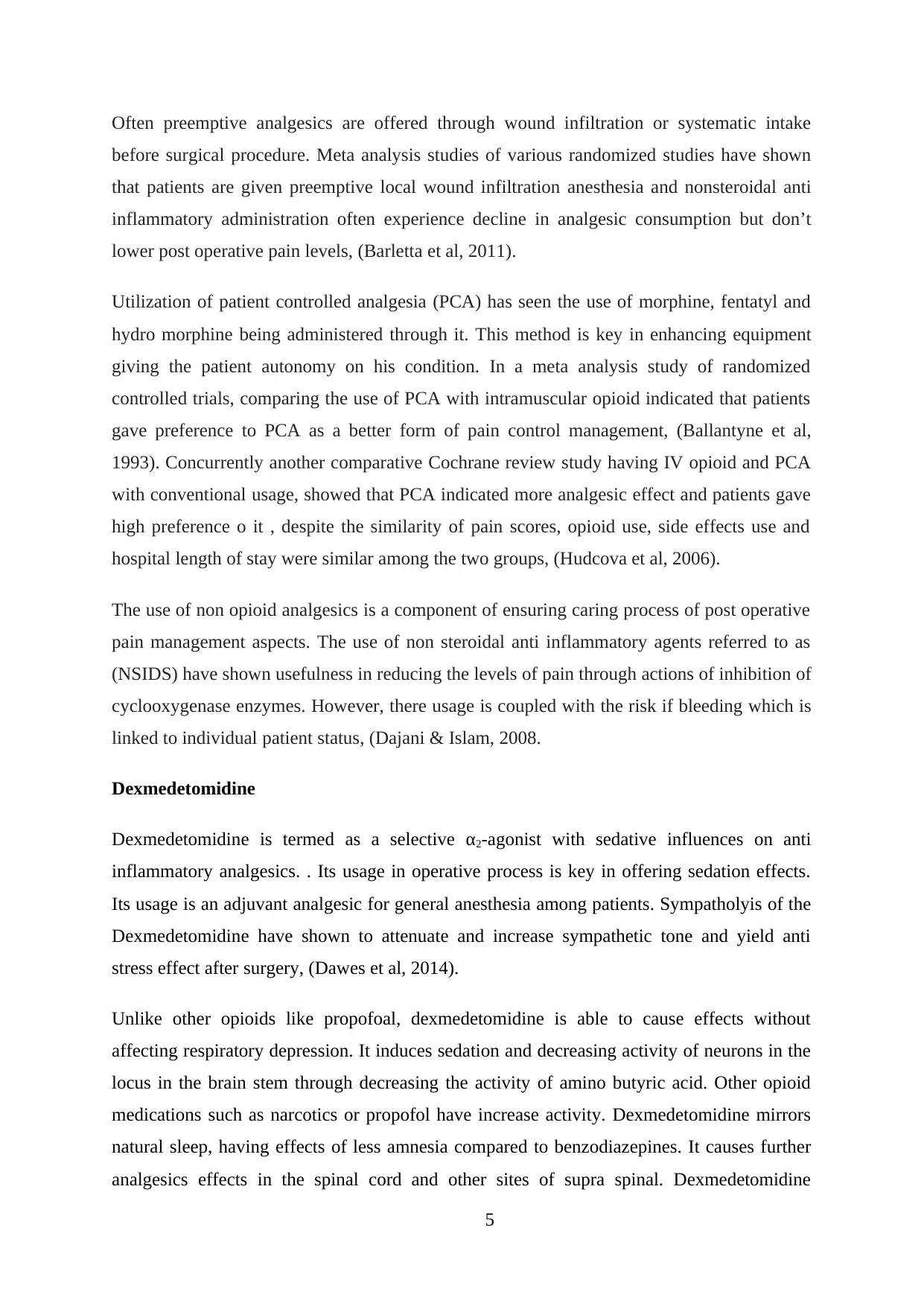
Often preemptive analgesics are offered through wound infiltration or systematic intake
before surgical procedure. Meta analysis studies of various randomized studies have shown
that patients are given preemptive local wound infiltration anesthesia and nonsteroidal anti
inflammatory administration often experience decline in analgesic consumption but don’t
lower post operative pain levels, (Barletta et al, 2011).
Utilization of patient controlled analgesia (PCA) has seen the use of morphine, fentatyl and
hydro morphine being administered through it. This method is key in enhancing equipment
giving the patient autonomy on his condition. In a meta analysis study of randomized
controlled trials, comparing the use of PCA with intramuscular opioid indicated that patients
gave preference to PCA as a better form of pain control management, (Ballantyne et al,
1993). Concurrently another comparative Cochrane review study having IV opioid and PCA
with conventional usage, showed that PCA indicated more analgesic effect and patients gave
high preference o it , despite the similarity of pain scores, opioid use, side effects use and
hospital length of stay were similar among the two groups, (Hudcova et al, 2006).
The use of non opioid analgesics is a component of ensuring caring process of post operative
pain management aspects. The use of non steroidal anti inflammatory agents referred to as
(NSIDS) have shown usefulness in reducing the levels of pain through actions of inhibition of
cyclooxygenase enzymes. However, there usage is coupled with the risk if bleeding which is
linked to individual patient status, (Dajani & Islam, 2008.
Dexmedetomidine
Dexmedetomidine is termed as a selective α2-agonist with sedative influences on anti
inflammatory analgesics. . Its usage in operative process is key in offering sedation effects.
Its usage is an adjuvant analgesic for general anesthesia among patients. Sympatholyis of the
Dexmedetomidine have shown to attenuate and increase sympathetic tone and yield anti
stress effect after surgery, (Dawes et al, 2014).
Unlike other opioids like propofoal, dexmedetomidine is able to cause effects without
affecting respiratory depression. It induces sedation and decreasing activity of neurons in the
locus in the brain stem through decreasing the activity of amino butyric acid. Other opioid
medications such as narcotics or propofol have increase activity. Dexmedetomidine mirrors
natural sleep, having effects of less amnesia compared to benzodiazepines. It causes further
analgesics effects in the spinal cord and other sites of supra spinal. Dexmedetomidine
5
before surgical procedure. Meta analysis studies of various randomized studies have shown
that patients are given preemptive local wound infiltration anesthesia and nonsteroidal anti
inflammatory administration often experience decline in analgesic consumption but don’t
lower post operative pain levels, (Barletta et al, 2011).
Utilization of patient controlled analgesia (PCA) has seen the use of morphine, fentatyl and
hydro morphine being administered through it. This method is key in enhancing equipment
giving the patient autonomy on his condition. In a meta analysis study of randomized
controlled trials, comparing the use of PCA with intramuscular opioid indicated that patients
gave preference to PCA as a better form of pain control management, (Ballantyne et al,
1993). Concurrently another comparative Cochrane review study having IV opioid and PCA
with conventional usage, showed that PCA indicated more analgesic effect and patients gave
high preference o it , despite the similarity of pain scores, opioid use, side effects use and
hospital length of stay were similar among the two groups, (Hudcova et al, 2006).
The use of non opioid analgesics is a component of ensuring caring process of post operative
pain management aspects. The use of non steroidal anti inflammatory agents referred to as
(NSIDS) have shown usefulness in reducing the levels of pain through actions of inhibition of
cyclooxygenase enzymes. However, there usage is coupled with the risk if bleeding which is
linked to individual patient status, (Dajani & Islam, 2008.
Dexmedetomidine
Dexmedetomidine is termed as a selective α2-agonist with sedative influences on anti
inflammatory analgesics. . Its usage in operative process is key in offering sedation effects.
Its usage is an adjuvant analgesic for general anesthesia among patients. Sympatholyis of the
Dexmedetomidine have shown to attenuate and increase sympathetic tone and yield anti
stress effect after surgery, (Dawes et al, 2014).
Unlike other opioids like propofoal, dexmedetomidine is able to cause effects without
affecting respiratory depression. It induces sedation and decreasing activity of neurons in the
locus in the brain stem through decreasing the activity of amino butyric acid. Other opioid
medications such as narcotics or propofol have increase activity. Dexmedetomidine mirrors
natural sleep, having effects of less amnesia compared to benzodiazepines. It causes further
analgesics effects in the spinal cord and other sites of supra spinal. Dexmedetomidine
5
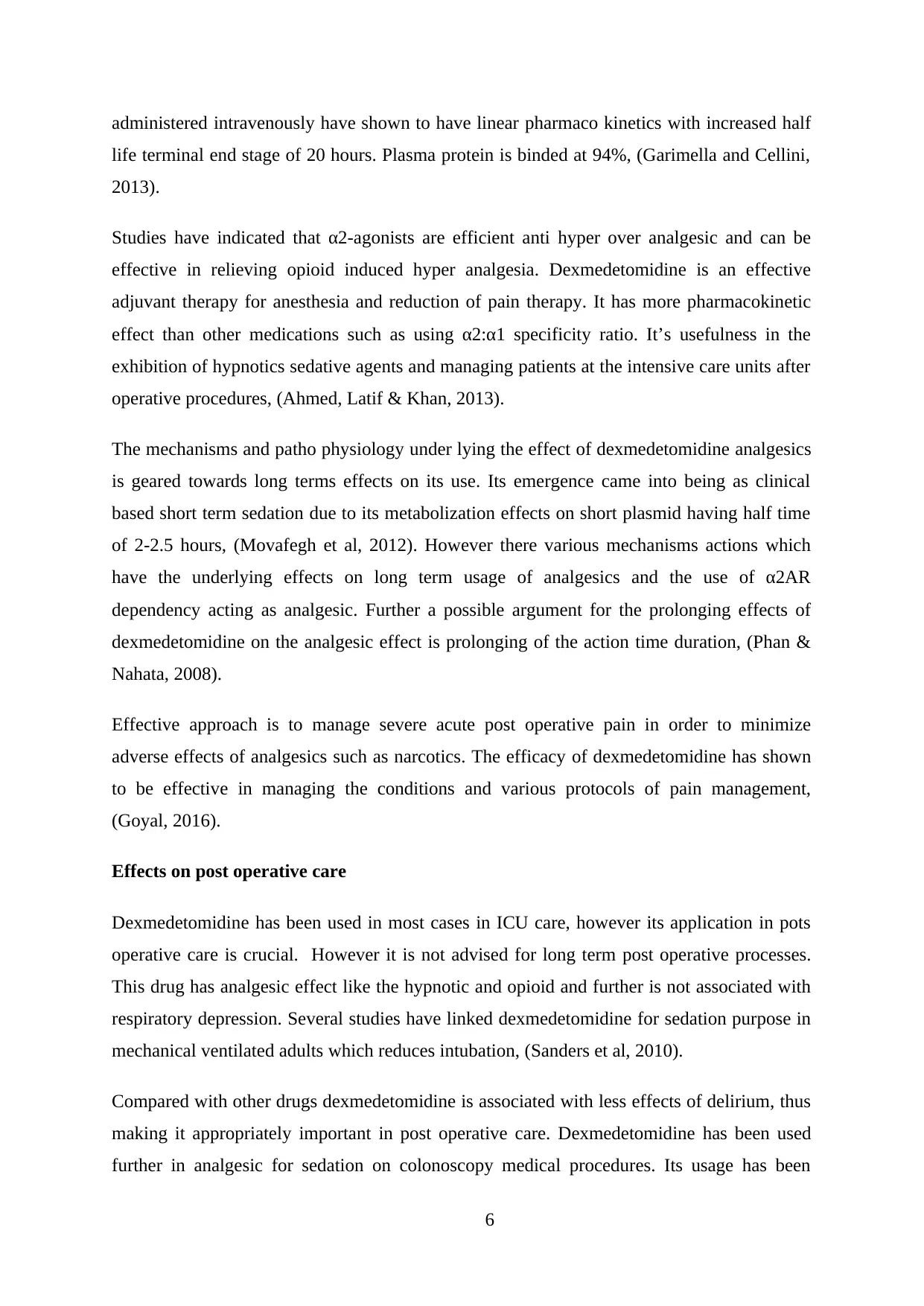
administered intravenously have shown to have linear pharmaco kinetics with increased half
life terminal end stage of 20 hours. Plasma protein is binded at 94%, (Garimella and Cellini,
2013).
Studies have indicated that α2-agonists are efficient anti hyper over analgesic and can be
effective in relieving opioid induced hyper analgesia. Dexmedetomidine is an effective
adjuvant therapy for anesthesia and reduction of pain therapy. It has more pharmacokinetic
effect than other medications such as using α2:α1 specificity ratio. It’s usefulness in the
exhibition of hypnotics sedative agents and managing patients at the intensive care units after
operative procedures, (Ahmed, Latif & Khan, 2013).
The mechanisms and patho physiology under lying the effect of dexmedetomidine analgesics
is geared towards long terms effects on its use. Its emergence came into being as clinical
based short term sedation due to its metabolization effects on short plasmid having half time
of 2-2.5 hours, (Movafegh et al, 2012). However there various mechanisms actions which
have the underlying effects on long term usage of analgesics and the use of α2AR
dependency acting as analgesic. Further a possible argument for the prolonging effects of
dexmedetomidine on the analgesic effect is prolonging of the action time duration, (Phan &
Nahata, 2008).
Effective approach is to manage severe acute post operative pain in order to minimize
adverse effects of analgesics such as narcotics. The efficacy of dexmedetomidine has shown
to be effective in managing the conditions and various protocols of pain management,
(Goyal, 2016).
Effects on post operative care
Dexmedetomidine has been used in most cases in ICU care, however its application in pots
operative care is crucial. However it is not advised for long term post operative processes.
This drug has analgesic effect like the hypnotic and opioid and further is not associated with
respiratory depression. Several studies have linked dexmedetomidine for sedation purpose in
mechanical ventilated adults which reduces intubation, (Sanders et al, 2010).
Compared with other drugs dexmedetomidine is associated with less effects of delirium, thus
making it appropriately important in post operative care. Dexmedetomidine has been used
further in analgesic for sedation on colonoscopy medical procedures. Its usage has been
6
life terminal end stage of 20 hours. Plasma protein is binded at 94%, (Garimella and Cellini,
2013).
Studies have indicated that α2-agonists are efficient anti hyper over analgesic and can be
effective in relieving opioid induced hyper analgesia. Dexmedetomidine is an effective
adjuvant therapy for anesthesia and reduction of pain therapy. It has more pharmacokinetic
effect than other medications such as using α2:α1 specificity ratio. It’s usefulness in the
exhibition of hypnotics sedative agents and managing patients at the intensive care units after
operative procedures, (Ahmed, Latif & Khan, 2013).
The mechanisms and patho physiology under lying the effect of dexmedetomidine analgesics
is geared towards long terms effects on its use. Its emergence came into being as clinical
based short term sedation due to its metabolization effects on short plasmid having half time
of 2-2.5 hours, (Movafegh et al, 2012). However there various mechanisms actions which
have the underlying effects on long term usage of analgesics and the use of α2AR
dependency acting as analgesic. Further a possible argument for the prolonging effects of
dexmedetomidine on the analgesic effect is prolonging of the action time duration, (Phan &
Nahata, 2008).
Effective approach is to manage severe acute post operative pain in order to minimize
adverse effects of analgesics such as narcotics. The efficacy of dexmedetomidine has shown
to be effective in managing the conditions and various protocols of pain management,
(Goyal, 2016).
Effects on post operative care
Dexmedetomidine has been used in most cases in ICU care, however its application in pots
operative care is crucial. However it is not advised for long term post operative processes.
This drug has analgesic effect like the hypnotic and opioid and further is not associated with
respiratory depression. Several studies have linked dexmedetomidine for sedation purpose in
mechanical ventilated adults which reduces intubation, (Sanders et al, 2010).
Compared with other drugs dexmedetomidine is associated with less effects of delirium, thus
making it appropriately important in post operative care. Dexmedetomidine has been used
further in analgesic for sedation on colonoscopy medical procedures. Its usage has been
6

effective as an adjunct sedative like those of opioids, proposal and benzodiazepines, this
enhances and maintains the stability through reduction of other sedatives, (Schnabel et al,
2013).
Dosage and administration of dexmedetomidine is done currently using intravenous infusion.
The differences in variability and hemodynamic effects, thus dosing effect must be adjusted
to ensure the desired effect. The assorted effects have shown no contraindication on the use
of dexmedetomidine. It has biphasic effect on blood pressure with lowered levels at higher
concentrations, (Yoshitomi et al, 2008).
Dexmedetomidine can be administered through intravenous means , the muscular method,
orally, buccaly and intranasal. The administration through the buccal method and intranasal
has high bioavailability to the body and can be easily tolerated in the body among
preoperative patients. Administration through the intranasal method using 1 μg/kg
dexmedetomidine and 0.2 mg/kg of midazolam before tonsillectomy of pediatric patients has
shown to have high level sedation. However, the use of dexmedetomidine reduced
significantly the dosage offered post operatively, indicating that dexmedetomidine
administered preoperative have impacts on the post operative patient care among children and
exhibit longer duration of dug impact on the body, (Shin et al, 2017).
A RCT study by Pestieau et al, (2011), showed that sedative and analgesics effects
administered internasally at 2 μg/kg fentanyl, and 1 μg/kg with 2 μg/kg od DEX during
pressure equalizing tube among children showed that DRX can reduced effectively the need
and importance of analgesics and further improve significantly peri operative pains. Dosages
of intranasal DEX thus should exceed 2 ug/kg during short surgical procedures for children.
Based on placebo controlled study involving intranasal 1ug/kg administration offered at 45
minutes before administration of local anesthesia among 30 patients undergoing minor tooth
molar surgical procedure were deeply administered the sedation with better outcome on post
operative pain Assesment after 2 hours during rest and before, (Cheung et al, 2011).
Concurrently another study administered dexmedetomidine through intra anal way at
1.5ug/kg given 1 hour before the local anesthesia administration among 30 patients prepared
to undergo functional surgery on sinus care. These patients were shown to require less
amounts of local anesthesia and had better postoperative comfort care coupled with analgesic
and homeostatic stuffing, (Tang et al, 2015).
7
enhances and maintains the stability through reduction of other sedatives, (Schnabel et al,
2013).
Dosage and administration of dexmedetomidine is done currently using intravenous infusion.
The differences in variability and hemodynamic effects, thus dosing effect must be adjusted
to ensure the desired effect. The assorted effects have shown no contraindication on the use
of dexmedetomidine. It has biphasic effect on blood pressure with lowered levels at higher
concentrations, (Yoshitomi et al, 2008).
Dexmedetomidine can be administered through intravenous means , the muscular method,
orally, buccaly and intranasal. The administration through the buccal method and intranasal
has high bioavailability to the body and can be easily tolerated in the body among
preoperative patients. Administration through the intranasal method using 1 μg/kg
dexmedetomidine and 0.2 mg/kg of midazolam before tonsillectomy of pediatric patients has
shown to have high level sedation. However, the use of dexmedetomidine reduced
significantly the dosage offered post operatively, indicating that dexmedetomidine
administered preoperative have impacts on the post operative patient care among children and
exhibit longer duration of dug impact on the body, (Shin et al, 2017).
A RCT study by Pestieau et al, (2011), showed that sedative and analgesics effects
administered internasally at 2 μg/kg fentanyl, and 1 μg/kg with 2 μg/kg od DEX during
pressure equalizing tube among children showed that DRX can reduced effectively the need
and importance of analgesics and further improve significantly peri operative pains. Dosages
of intranasal DEX thus should exceed 2 ug/kg during short surgical procedures for children.
Based on placebo controlled study involving intranasal 1ug/kg administration offered at 45
minutes before administration of local anesthesia among 30 patients undergoing minor tooth
molar surgical procedure were deeply administered the sedation with better outcome on post
operative pain Assesment after 2 hours during rest and before, (Cheung et al, 2011).
Concurrently another study administered dexmedetomidine through intra anal way at
1.5ug/kg given 1 hour before the local anesthesia administration among 30 patients prepared
to undergo functional surgery on sinus care. These patients were shown to require less
amounts of local anesthesia and had better postoperative comfort care coupled with analgesic
and homeostatic stuffing, (Tang et al, 2015).
7
Paraphrase This Document
Need a fresh take? Get an instant paraphrase of this document with our AI Paraphraser
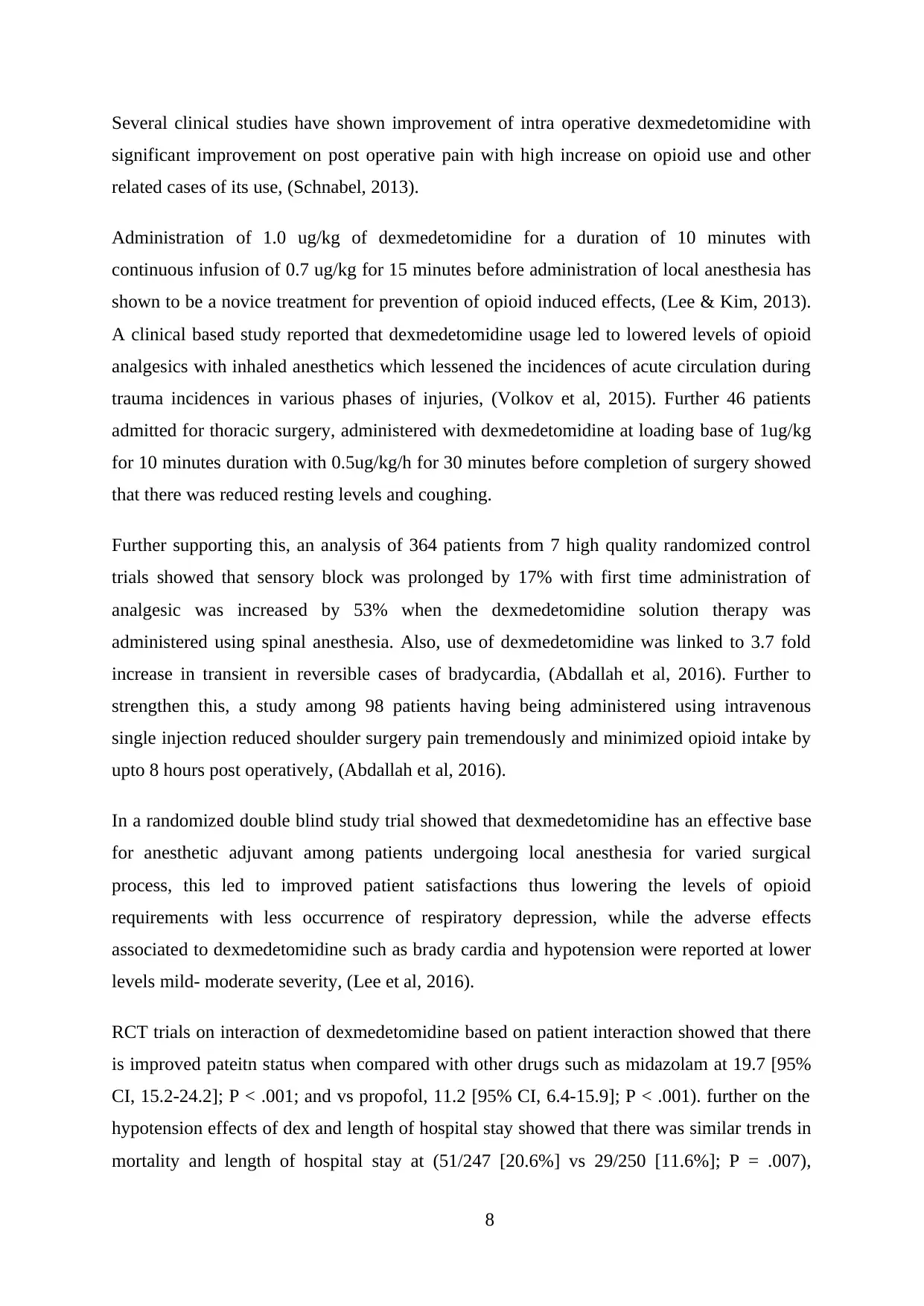
Several clinical studies have shown improvement of intra operative dexmedetomidine with
significant improvement on post operative pain with high increase on opioid use and other
related cases of its use, (Schnabel, 2013).
Administration of 1.0 ug/kg of dexmedetomidine for a duration of 10 minutes with
continuous infusion of 0.7 ug/kg for 15 minutes before administration of local anesthesia has
shown to be a novice treatment for prevention of opioid induced effects, (Lee & Kim, 2013).
A clinical based study reported that dexmedetomidine usage led to lowered levels of opioid
analgesics with inhaled anesthetics which lessened the incidences of acute circulation during
trauma incidences in various phases of injuries, (Volkov et al, 2015). Further 46 patients
admitted for thoracic surgery, administered with dexmedetomidine at loading base of 1ug/kg
for 10 minutes duration with 0.5ug/kg/h for 30 minutes before completion of surgery showed
that there was reduced resting levels and coughing.
Further supporting this, an analysis of 364 patients from 7 high quality randomized control
trials showed that sensory block was prolonged by 17% with first time administration of
analgesic was increased by 53% when the dexmedetomidine solution therapy was
administered using spinal anesthesia. Also, use of dexmedetomidine was linked to 3.7 fold
increase in transient in reversible cases of bradycardia, (Abdallah et al, 2016). Further to
strengthen this, a study among 98 patients having being administered using intravenous
single injection reduced shoulder surgery pain tremendously and minimized opioid intake by
upto 8 hours post operatively, (Abdallah et al, 2016).
In a randomized double blind study trial showed that dexmedetomidine has an effective base
for anesthetic adjuvant among patients undergoing local anesthesia for varied surgical
process, this led to improved patient satisfactions thus lowering the levels of opioid
requirements with less occurrence of respiratory depression, while the adverse effects
associated to dexmedetomidine such as brady cardia and hypotension were reported at lower
levels mild- moderate severity, (Lee et al, 2016).
RCT trials on interaction of dexmedetomidine based on patient interaction showed that there
is improved pateitn status when compared with other drugs such as midazolam at 19.7 [95%
CI, 15.2-24.2]; P < .001; and vs propofol, 11.2 [95% CI, 6.4-15.9]; P < .001). further on the
hypotension effects of dex and length of hospital stay showed that there was similar trends in
mortality and length of hospital stay at (51/247 [20.6%] vs 29/250 [11.6%]; P = .007),
8
significant improvement on post operative pain with high increase on opioid use and other
related cases of its use, (Schnabel, 2013).
Administration of 1.0 ug/kg of dexmedetomidine for a duration of 10 minutes with
continuous infusion of 0.7 ug/kg for 15 minutes before administration of local anesthesia has
shown to be a novice treatment for prevention of opioid induced effects, (Lee & Kim, 2013).
A clinical based study reported that dexmedetomidine usage led to lowered levels of opioid
analgesics with inhaled anesthetics which lessened the incidences of acute circulation during
trauma incidences in various phases of injuries, (Volkov et al, 2015). Further 46 patients
admitted for thoracic surgery, administered with dexmedetomidine at loading base of 1ug/kg
for 10 minutes duration with 0.5ug/kg/h for 30 minutes before completion of surgery showed
that there was reduced resting levels and coughing.
Further supporting this, an analysis of 364 patients from 7 high quality randomized control
trials showed that sensory block was prolonged by 17% with first time administration of
analgesic was increased by 53% when the dexmedetomidine solution therapy was
administered using spinal anesthesia. Also, use of dexmedetomidine was linked to 3.7 fold
increase in transient in reversible cases of bradycardia, (Abdallah et al, 2016). Further to
strengthen this, a study among 98 patients having being administered using intravenous
single injection reduced shoulder surgery pain tremendously and minimized opioid intake by
upto 8 hours post operatively, (Abdallah et al, 2016).
In a randomized double blind study trial showed that dexmedetomidine has an effective base
for anesthetic adjuvant among patients undergoing local anesthesia for varied surgical
process, this led to improved patient satisfactions thus lowering the levels of opioid
requirements with less occurrence of respiratory depression, while the adverse effects
associated to dexmedetomidine such as brady cardia and hypotension were reported at lower
levels mild- moderate severity, (Lee et al, 2016).
RCT trials on interaction of dexmedetomidine based on patient interaction showed that there
is improved pateitn status when compared with other drugs such as midazolam at 19.7 [95%
CI, 15.2-24.2]; P < .001; and vs propofol, 11.2 [95% CI, 6.4-15.9]; P < .001). further on the
hypotension effects of dex and length of hospital stay showed that there was similar trends in
mortality and length of hospital stay at (51/247 [20.6%] vs 29/250 [11.6%]; P = .007),
8
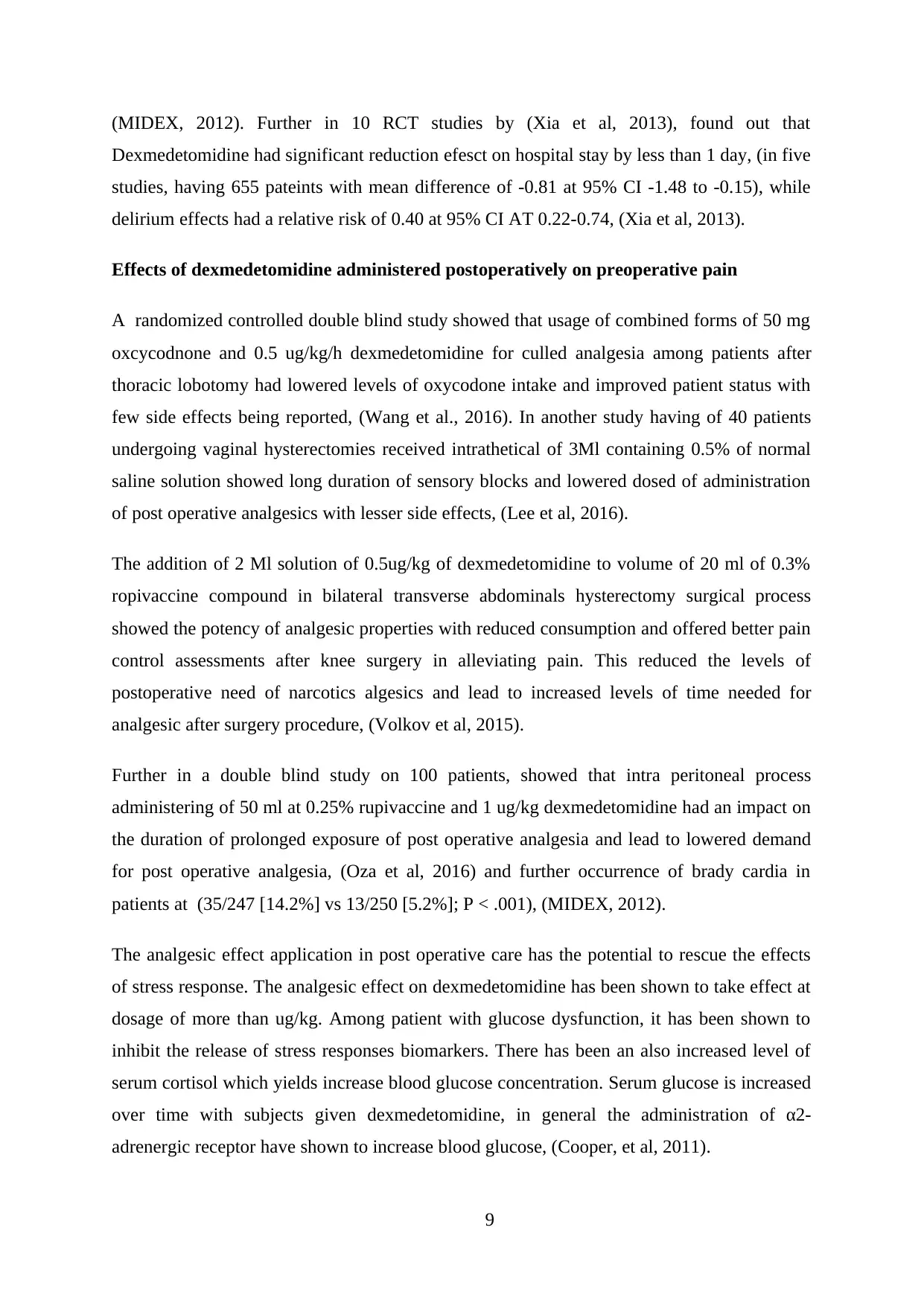
(MIDEX, 2012). Further in 10 RCT studies by (Xia et al, 2013), found out that
Dexmedetomidine had significant reduction efesct on hospital stay by less than 1 day, (in five
studies, having 655 pateints with mean difference of -0.81 at 95% CI -1.48 to -0.15), while
delirium effects had a relative risk of 0.40 at 95% CI AT 0.22-0.74, (Xia et al, 2013).
Effects of dexmedetomidine administered postoperatively on preoperative pain
A randomized controlled double blind study showed that usage of combined forms of 50 mg
oxcycodnone and 0.5 ug/kg/h dexmedetomidine for culled analgesia among patients after
thoracic lobotomy had lowered levels of oxycodone intake and improved patient status with
few side effects being reported, (Wang et al., 2016). In another study having of 40 patients
undergoing vaginal hysterectomies received intrathetical of 3Ml containing 0.5% of normal
saline solution showed long duration of sensory blocks and lowered dosed of administration
of post operative analgesics with lesser side effects, (Lee et al, 2016).
The addition of 2 Ml solution of 0.5ug/kg of dexmedetomidine to volume of 20 ml of 0.3%
ropivaccine compound in bilateral transverse abdominals hysterectomy surgical process
showed the potency of analgesic properties with reduced consumption and offered better pain
control assessments after knee surgery in alleviating pain. This reduced the levels of
postoperative need of narcotics algesics and lead to increased levels of time needed for
analgesic after surgery procedure, (Volkov et al, 2015).
Further in a double blind study on 100 patients, showed that intra peritoneal process
administering of 50 ml at 0.25% rupivaccine and 1 ug/kg dexmedetomidine had an impact on
the duration of prolonged exposure of post operative analgesia and lead to lowered demand
for post operative analgesia, (Oza et al, 2016) and further occurrence of brady cardia in
patients at (35/247 [14.2%] vs 13/250 [5.2%]; P < .001), (MIDEX, 2012).
The analgesic effect application in post operative care has the potential to rescue the effects
of stress response. The analgesic effect on dexmedetomidine has been shown to take effect at
dosage of more than ug/kg. Among patient with glucose dysfunction, it has been shown to
inhibit the release of stress responses biomarkers. There has been an also increased level of
serum cortisol which yields increase blood glucose concentration. Serum glucose is increased
over time with subjects given dexmedetomidine, in general the administration of α2-
adrenergic receptor have shown to increase blood glucose, (Cooper, et al, 2011).
9
Dexmedetomidine had significant reduction efesct on hospital stay by less than 1 day, (in five
studies, having 655 pateints with mean difference of -0.81 at 95% CI -1.48 to -0.15), while
delirium effects had a relative risk of 0.40 at 95% CI AT 0.22-0.74, (Xia et al, 2013).
Effects of dexmedetomidine administered postoperatively on preoperative pain
A randomized controlled double blind study showed that usage of combined forms of 50 mg
oxcycodnone and 0.5 ug/kg/h dexmedetomidine for culled analgesia among patients after
thoracic lobotomy had lowered levels of oxycodone intake and improved patient status with
few side effects being reported, (Wang et al., 2016). In another study having of 40 patients
undergoing vaginal hysterectomies received intrathetical of 3Ml containing 0.5% of normal
saline solution showed long duration of sensory blocks and lowered dosed of administration
of post operative analgesics with lesser side effects, (Lee et al, 2016).
The addition of 2 Ml solution of 0.5ug/kg of dexmedetomidine to volume of 20 ml of 0.3%
ropivaccine compound in bilateral transverse abdominals hysterectomy surgical process
showed the potency of analgesic properties with reduced consumption and offered better pain
control assessments after knee surgery in alleviating pain. This reduced the levels of
postoperative need of narcotics algesics and lead to increased levels of time needed for
analgesic after surgery procedure, (Volkov et al, 2015).
Further in a double blind study on 100 patients, showed that intra peritoneal process
administering of 50 ml at 0.25% rupivaccine and 1 ug/kg dexmedetomidine had an impact on
the duration of prolonged exposure of post operative analgesia and lead to lowered demand
for post operative analgesia, (Oza et al, 2016) and further occurrence of brady cardia in
patients at (35/247 [14.2%] vs 13/250 [5.2%]; P < .001), (MIDEX, 2012).
The analgesic effect application in post operative care has the potential to rescue the effects
of stress response. The analgesic effect on dexmedetomidine has been shown to take effect at
dosage of more than ug/kg. Among patient with glucose dysfunction, it has been shown to
inhibit the release of stress responses biomarkers. There has been an also increased level of
serum cortisol which yields increase blood glucose concentration. Serum glucose is increased
over time with subjects given dexmedetomidine, in general the administration of α2-
adrenergic receptor have shown to increase blood glucose, (Cooper, et al, 2011).
9

Further the administration of dexmedetomidine has been shown to have an effect on the
hemodynamic effect on the sympatholytic effects. Dexmedetomidine causes do depended
sedations, anxio lyses and analgesia without any form of respiratory depression.
Dexmedetomidine has been shown to enhance anesthesia from other drugs and causes peri
operative sympatholysis, (Geng et al, 2016).
The notable side effects of this compound include adverse effects like hypotension,
hypertension, brady cardia and nausea. Other side effects which have been noticed include
fever, cynosis, muscle weakness and rigors. Further it may lead to pulmonary edema, lactic
acidosis, paresis and even hyper gylkycameia. Tolerability factors have been linked to
dexmedetomidine among subjects who achieved concentrations of 1.8 upto 13 times, (Song et
al, 2016).
Guidelines on usage of dexmedetomidine
Medical based organizations such as AAGBI and NHS have formulated guidelines to guide
the usage of local anesthetic toxicology. Following the frameworks is key one ensuring that
safety is met with its usage. AAGBI has outlined four basic process which guides its’
application. The first is the recognition of any sever toxicity which the medical practitioners
needs to be aware, followed by the immediate management care process when severe toxicity
is notices. At this point treatment is offered and follow up initiated for the patients, (AAGBI,
2018).
NHS has outlined basic guidelines on the side effects associated with anesthesia drugs. The
overview gives medical practitioners on the basic side effects associated with anesthesia.
Anesthesia can cause various effects include permanent and allergic reaction o medication
process. It gives outlines on how to use with regard to the patient history, medical factors,
procedure type and type of anesthesia applied. This guideline serves as framework of using
dexmedetomidine in preoperative and managing post operative pain among surgical patients,
(NHS, 2018).
Best practices
It is estimated that almost 2-5 of the patients who are undergoing post operative care often
experience severe post operative pain which is linked to sever pain. Administrations of
opioids such as narcotics which are morphine based in nature for pain control have been
10
hemodynamic effect on the sympatholytic effects. Dexmedetomidine causes do depended
sedations, anxio lyses and analgesia without any form of respiratory depression.
Dexmedetomidine has been shown to enhance anesthesia from other drugs and causes peri
operative sympatholysis, (Geng et al, 2016).
The notable side effects of this compound include adverse effects like hypotension,
hypertension, brady cardia and nausea. Other side effects which have been noticed include
fever, cynosis, muscle weakness and rigors. Further it may lead to pulmonary edema, lactic
acidosis, paresis and even hyper gylkycameia. Tolerability factors have been linked to
dexmedetomidine among subjects who achieved concentrations of 1.8 upto 13 times, (Song et
al, 2016).
Guidelines on usage of dexmedetomidine
Medical based organizations such as AAGBI and NHS have formulated guidelines to guide
the usage of local anesthetic toxicology. Following the frameworks is key one ensuring that
safety is met with its usage. AAGBI has outlined four basic process which guides its’
application. The first is the recognition of any sever toxicity which the medical practitioners
needs to be aware, followed by the immediate management care process when severe toxicity
is notices. At this point treatment is offered and follow up initiated for the patients, (AAGBI,
2018).
NHS has outlined basic guidelines on the side effects associated with anesthesia drugs. The
overview gives medical practitioners on the basic side effects associated with anesthesia.
Anesthesia can cause various effects include permanent and allergic reaction o medication
process. It gives outlines on how to use with regard to the patient history, medical factors,
procedure type and type of anesthesia applied. This guideline serves as framework of using
dexmedetomidine in preoperative and managing post operative pain among surgical patients,
(NHS, 2018).
Best practices
It is estimated that almost 2-5 of the patients who are undergoing post operative care often
experience severe post operative pain which is linked to sever pain. Administrations of
opioids such as narcotics which are morphine based in nature for pain control have been
10
Secure Best Marks with AI Grader
Need help grading? Try our AI Grader for instant feedback on your assignments.
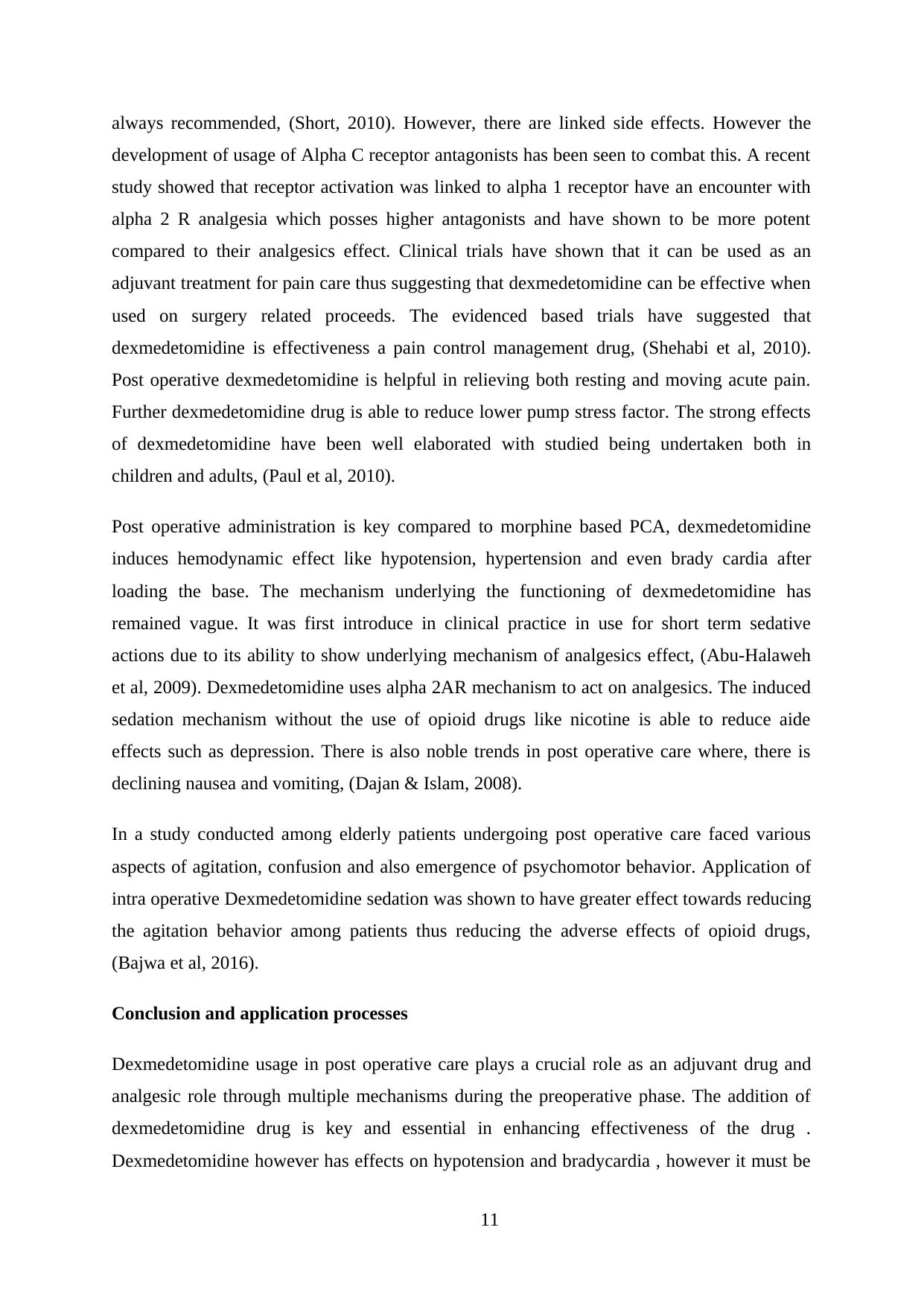
always recommended, (Short, 2010). However, there are linked side effects. However the
development of usage of Alpha C receptor antagonists has been seen to combat this. A recent
study showed that receptor activation was linked to alpha 1 receptor have an encounter with
alpha 2 R analgesia which posses higher antagonists and have shown to be more potent
compared to their analgesics effect. Clinical trials have shown that it can be used as an
adjuvant treatment for pain care thus suggesting that dexmedetomidine can be effective when
used on surgery related proceeds. The evidenced based trials have suggested that
dexmedetomidine is effectiveness a pain control management drug, (Shehabi et al, 2010).
Post operative dexmedetomidine is helpful in relieving both resting and moving acute pain.
Further dexmedetomidine drug is able to reduce lower pump stress factor. The strong effects
of dexmedetomidine have been well elaborated with studied being undertaken both in
children and adults, (Paul et al, 2010).
Post operative administration is key compared to morphine based PCA, dexmedetomidine
induces hemodynamic effect like hypotension, hypertension and even brady cardia after
loading the base. The mechanism underlying the functioning of dexmedetomidine has
remained vague. It was first introduce in clinical practice in use for short term sedative
actions due to its ability to show underlying mechanism of analgesics effect, (Abu-Halaweh
et al, 2009). Dexmedetomidine uses alpha 2AR mechanism to act on analgesics. The induced
sedation mechanism without the use of opioid drugs like nicotine is able to reduce aide
effects such as depression. There is also noble trends in post operative care where, there is
declining nausea and vomiting, (Dajan & Islam, 2008).
In a study conducted among elderly patients undergoing post operative care faced various
aspects of agitation, confusion and also emergence of psychomotor behavior. Application of
intra operative Dexmedetomidine sedation was shown to have greater effect towards reducing
the agitation behavior among patients thus reducing the adverse effects of opioid drugs,
(Bajwa et al, 2016).
Conclusion and application processes
Dexmedetomidine usage in post operative care plays a crucial role as an adjuvant drug and
analgesic role through multiple mechanisms during the preoperative phase. The addition of
dexmedetomidine drug is key and essential in enhancing effectiveness of the drug .
Dexmedetomidine however has effects on hypotension and bradycardia , however it must be
11
development of usage of Alpha C receptor antagonists has been seen to combat this. A recent
study showed that receptor activation was linked to alpha 1 receptor have an encounter with
alpha 2 R analgesia which posses higher antagonists and have shown to be more potent
compared to their analgesics effect. Clinical trials have shown that it can be used as an
adjuvant treatment for pain care thus suggesting that dexmedetomidine can be effective when
used on surgery related proceeds. The evidenced based trials have suggested that
dexmedetomidine is effectiveness a pain control management drug, (Shehabi et al, 2010).
Post operative dexmedetomidine is helpful in relieving both resting and moving acute pain.
Further dexmedetomidine drug is able to reduce lower pump stress factor. The strong effects
of dexmedetomidine have been well elaborated with studied being undertaken both in
children and adults, (Paul et al, 2010).
Post operative administration is key compared to morphine based PCA, dexmedetomidine
induces hemodynamic effect like hypotension, hypertension and even brady cardia after
loading the base. The mechanism underlying the functioning of dexmedetomidine has
remained vague. It was first introduce in clinical practice in use for short term sedative
actions due to its ability to show underlying mechanism of analgesics effect, (Abu-Halaweh
et al, 2009). Dexmedetomidine uses alpha 2AR mechanism to act on analgesics. The induced
sedation mechanism without the use of opioid drugs like nicotine is able to reduce aide
effects such as depression. There is also noble trends in post operative care where, there is
declining nausea and vomiting, (Dajan & Islam, 2008).
In a study conducted among elderly patients undergoing post operative care faced various
aspects of agitation, confusion and also emergence of psychomotor behavior. Application of
intra operative Dexmedetomidine sedation was shown to have greater effect towards reducing
the agitation behavior among patients thus reducing the adverse effects of opioid drugs,
(Bajwa et al, 2016).
Conclusion and application processes
Dexmedetomidine usage in post operative care plays a crucial role as an adjuvant drug and
analgesic role through multiple mechanisms during the preoperative phase. The addition of
dexmedetomidine drug is key and essential in enhancing effectiveness of the drug .
Dexmedetomidine however has effects on hypotension and bradycardia , however it must be
11
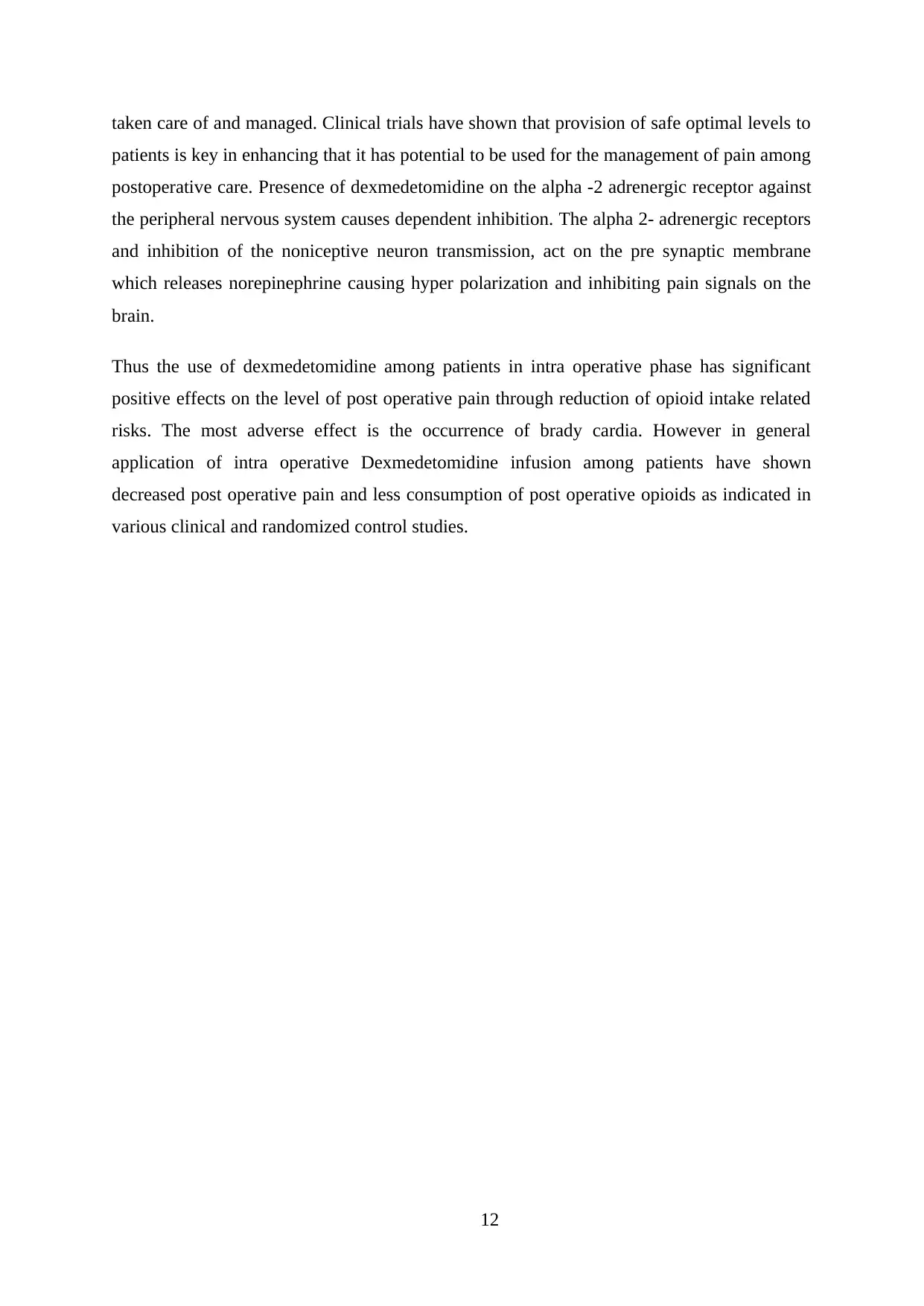
taken care of and managed. Clinical trials have shown that provision of safe optimal levels to
patients is key in enhancing that it has potential to be used for the management of pain among
postoperative care. Presence of dexmedetomidine on the alpha -2 adrenergic receptor against
the peripheral nervous system causes dependent inhibition. The alpha 2- adrenergic receptors
and inhibition of the noniceptive neuron transmission, act on the pre synaptic membrane
which releases norepinephrine causing hyper polarization and inhibiting pain signals on the
brain.
Thus the use of dexmedetomidine among patients in intra operative phase has significant
positive effects on the level of post operative pain through reduction of opioid intake related
risks. The most adverse effect is the occurrence of brady cardia. However in general
application of intra operative Dexmedetomidine infusion among patients have shown
decreased post operative pain and less consumption of post operative opioids as indicated in
various clinical and randomized control studies.
12
patients is key in enhancing that it has potential to be used for the management of pain among
postoperative care. Presence of dexmedetomidine on the alpha -2 adrenergic receptor against
the peripheral nervous system causes dependent inhibition. The alpha 2- adrenergic receptors
and inhibition of the noniceptive neuron transmission, act on the pre synaptic membrane
which releases norepinephrine causing hyper polarization and inhibiting pain signals on the
brain.
Thus the use of dexmedetomidine among patients in intra operative phase has significant
positive effects on the level of post operative pain through reduction of opioid intake related
risks. The most adverse effect is the occurrence of brady cardia. However in general
application of intra operative Dexmedetomidine infusion among patients have shown
decreased post operative pain and less consumption of post operative opioids as indicated in
various clinical and randomized control studies.
12
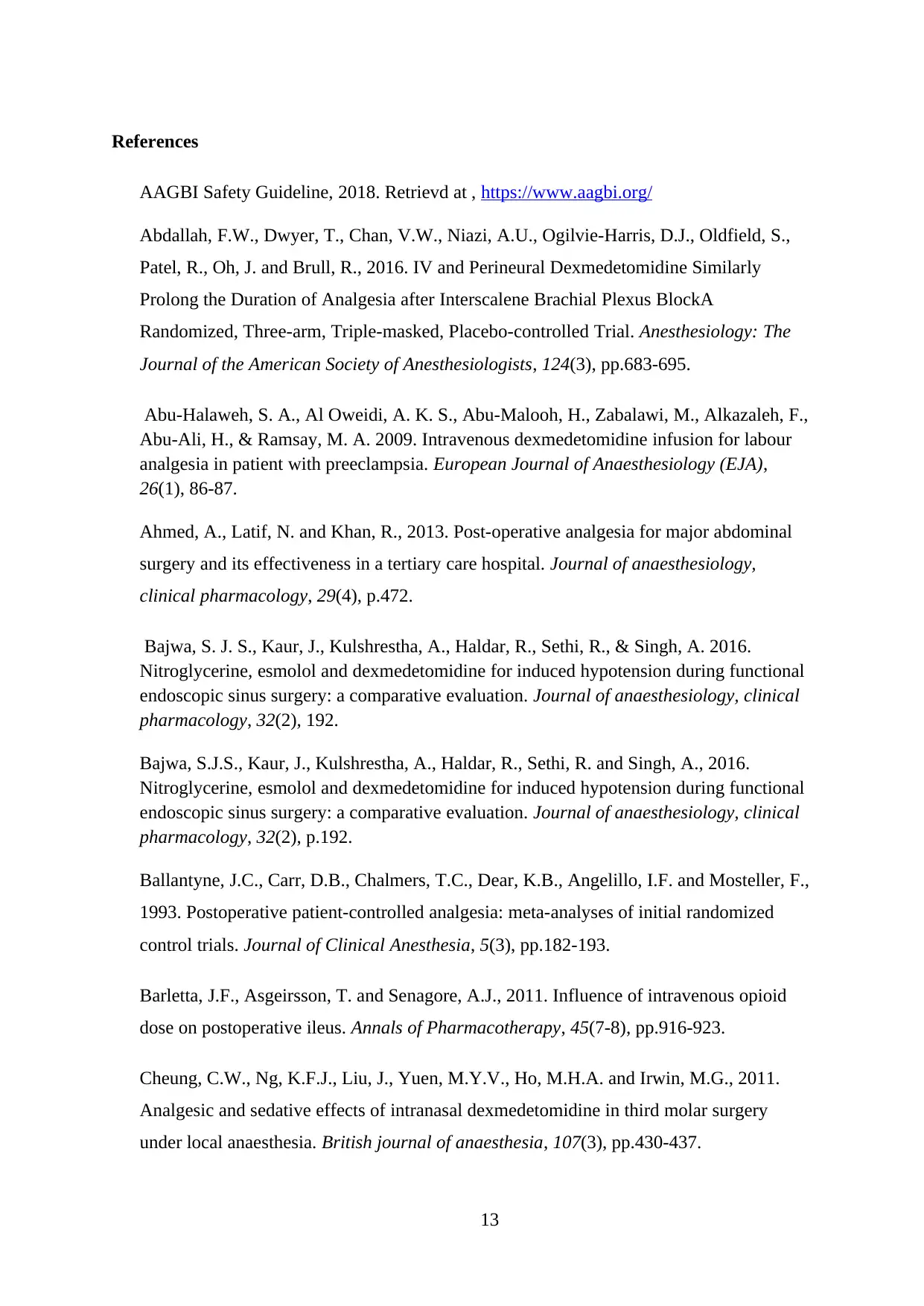
References
AAGBI Safety Guideline, 2018. Retrievd at , https://www.aagbi.org/
Abdallah, F.W., Dwyer, T., Chan, V.W., Niazi, A.U., Ogilvie-Harris, D.J., Oldfield, S.,
Patel, R., Oh, J. and Brull, R., 2016. IV and Perineural Dexmedetomidine Similarly
Prolong the Duration of Analgesia after Interscalene Brachial Plexus BlockA
Randomized, Three-arm, Triple-masked, Placebo-controlled Trial. Anesthesiology: The
Journal of the American Society of Anesthesiologists, 124(3), pp.683-695.
Abu-Halaweh, S. A., Al Oweidi, A. K. S., Abu-Malooh, H., Zabalawi, M., Alkazaleh, F.,
Abu-Ali, H., & Ramsay, M. A. 2009. Intravenous dexmedetomidine infusion for labour
analgesia in patient with preeclampsia. European Journal of Anaesthesiology (EJA),
26(1), 86-87.
Ahmed, A., Latif, N. and Khan, R., 2013. Post-operative analgesia for major abdominal
surgery and its effectiveness in a tertiary care hospital. Journal of anaesthesiology,
clinical pharmacology, 29(4), p.472.
Bajwa, S. J. S., Kaur, J., Kulshrestha, A., Haldar, R., Sethi, R., & Singh, A. 2016.
Nitroglycerine, esmolol and dexmedetomidine for induced hypotension during functional
endoscopic sinus surgery: a comparative evaluation. Journal of anaesthesiology, clinical
pharmacology, 32(2), 192.
Bajwa, S.J.S., Kaur, J., Kulshrestha, A., Haldar, R., Sethi, R. and Singh, A., 2016.
Nitroglycerine, esmolol and dexmedetomidine for induced hypotension during functional
endoscopic sinus surgery: a comparative evaluation. Journal of anaesthesiology, clinical
pharmacology, 32(2), p.192.
Ballantyne, J.C., Carr, D.B., Chalmers, T.C., Dear, K.B., Angelillo, I.F. and Mosteller, F.,
1993. Postoperative patient-controlled analgesia: meta-analyses of initial randomized
control trials. Journal of Clinical Anesthesia, 5(3), pp.182-193.
Barletta, J.F., Asgeirsson, T. and Senagore, A.J., 2011. Influence of intravenous opioid
dose on postoperative ileus. Annals of Pharmacotherapy, 45(7-8), pp.916-923.
Cheung, C.W., Ng, K.F.J., Liu, J., Yuen, M.Y.V., Ho, M.H.A. and Irwin, M.G., 2011.
Analgesic and sedative effects of intranasal dexmedetomidine in third molar surgery
under local anaesthesia. British journal of anaesthesia, 107(3), pp.430-437.
13
AAGBI Safety Guideline, 2018. Retrievd at , https://www.aagbi.org/
Abdallah, F.W., Dwyer, T., Chan, V.W., Niazi, A.U., Ogilvie-Harris, D.J., Oldfield, S.,
Patel, R., Oh, J. and Brull, R., 2016. IV and Perineural Dexmedetomidine Similarly
Prolong the Duration of Analgesia after Interscalene Brachial Plexus BlockA
Randomized, Three-arm, Triple-masked, Placebo-controlled Trial. Anesthesiology: The
Journal of the American Society of Anesthesiologists, 124(3), pp.683-695.
Abu-Halaweh, S. A., Al Oweidi, A. K. S., Abu-Malooh, H., Zabalawi, M., Alkazaleh, F.,
Abu-Ali, H., & Ramsay, M. A. 2009. Intravenous dexmedetomidine infusion for labour
analgesia in patient with preeclampsia. European Journal of Anaesthesiology (EJA),
26(1), 86-87.
Ahmed, A., Latif, N. and Khan, R., 2013. Post-operative analgesia for major abdominal
surgery and its effectiveness in a tertiary care hospital. Journal of anaesthesiology,
clinical pharmacology, 29(4), p.472.
Bajwa, S. J. S., Kaur, J., Kulshrestha, A., Haldar, R., Sethi, R., & Singh, A. 2016.
Nitroglycerine, esmolol and dexmedetomidine for induced hypotension during functional
endoscopic sinus surgery: a comparative evaluation. Journal of anaesthesiology, clinical
pharmacology, 32(2), 192.
Bajwa, S.J.S., Kaur, J., Kulshrestha, A., Haldar, R., Sethi, R. and Singh, A., 2016.
Nitroglycerine, esmolol and dexmedetomidine for induced hypotension during functional
endoscopic sinus surgery: a comparative evaluation. Journal of anaesthesiology, clinical
pharmacology, 32(2), p.192.
Ballantyne, J.C., Carr, D.B., Chalmers, T.C., Dear, K.B., Angelillo, I.F. and Mosteller, F.,
1993. Postoperative patient-controlled analgesia: meta-analyses of initial randomized
control trials. Journal of Clinical Anesthesia, 5(3), pp.182-193.
Barletta, J.F., Asgeirsson, T. and Senagore, A.J., 2011. Influence of intravenous opioid
dose on postoperative ileus. Annals of Pharmacotherapy, 45(7-8), pp.916-923.
Cheung, C.W., Ng, K.F.J., Liu, J., Yuen, M.Y.V., Ho, M.H.A. and Irwin, M.G., 2011.
Analgesic and sedative effects of intranasal dexmedetomidine in third molar surgery
under local anaesthesia. British journal of anaesthesia, 107(3), pp.430-437.
13
Paraphrase This Document
Need a fresh take? Get an instant paraphrase of this document with our AI Paraphraser
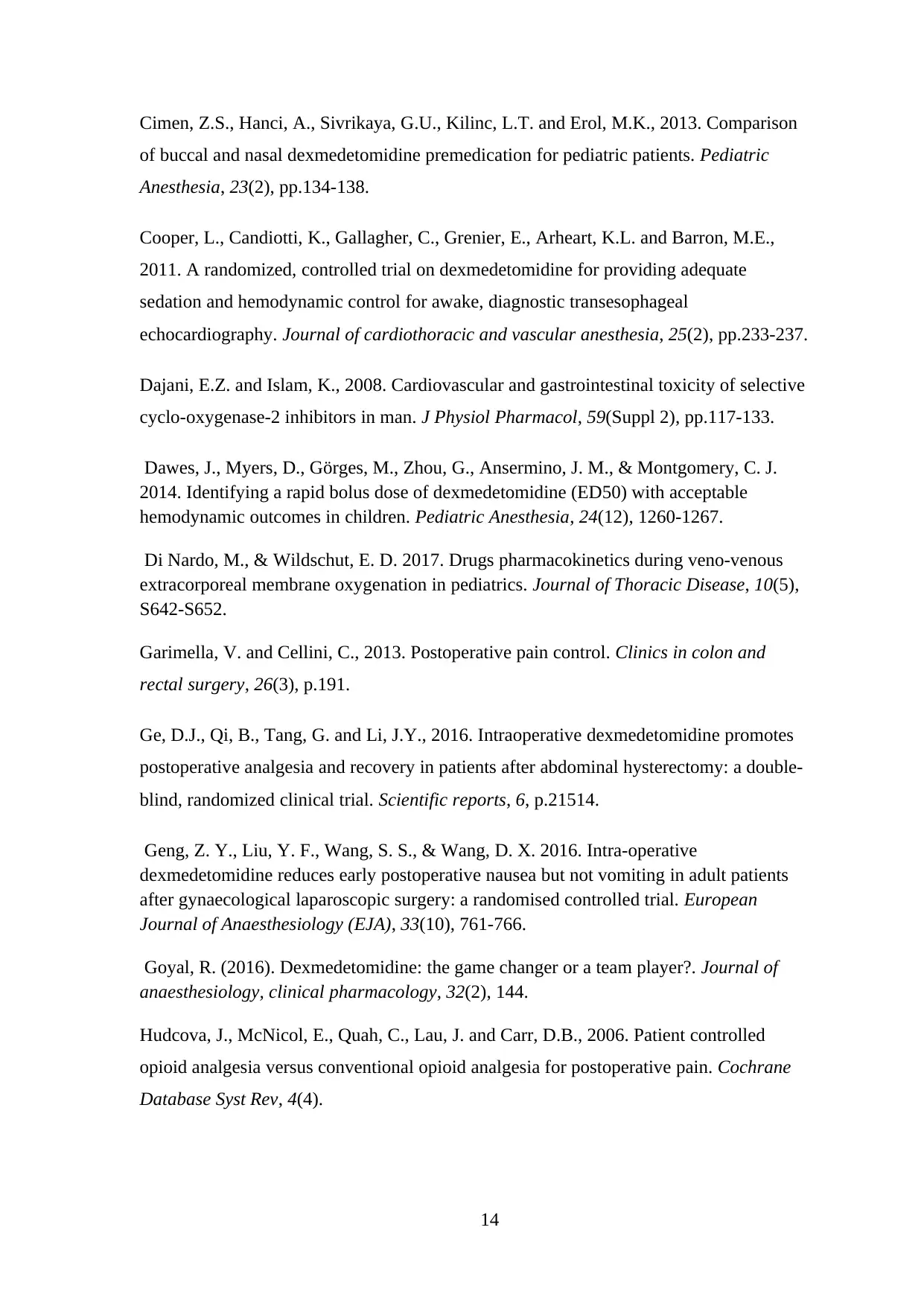
Cimen, Z.S., Hanci, A., Sivrikaya, G.U., Kilinc, L.T. and Erol, M.K., 2013. Comparison
of buccal and nasal dexmedetomidine premedication for pediatric patients. Pediatric
Anesthesia, 23(2), pp.134-138.
Cooper, L., Candiotti, K., Gallagher, C., Grenier, E., Arheart, K.L. and Barron, M.E.,
2011. A randomized, controlled trial on dexmedetomidine for providing adequate
sedation and hemodynamic control for awake, diagnostic transesophageal
echocardiography. Journal of cardiothoracic and vascular anesthesia, 25(2), pp.233-237.
Dajani, E.Z. and Islam, K., 2008. Cardiovascular and gastrointestinal toxicity of selective
cyclo-oxygenase-2 inhibitors in man. J Physiol Pharmacol, 59(Suppl 2), pp.117-133.
Dawes, J., Myers, D., Görges, M., Zhou, G., Ansermino, J. M., & Montgomery, C. J.
2014. Identifying a rapid bolus dose of dexmedetomidine (ED50) with acceptable
hemodynamic outcomes in children. Pediatric Anesthesia, 24(12), 1260-1267.
Di Nardo, M., & Wildschut, E. D. 2017. Drugs pharmacokinetics during veno-venous
extracorporeal membrane oxygenation in pediatrics. Journal of Thoracic Disease, 10(5),
S642-S652.
Garimella, V. and Cellini, C., 2013. Postoperative pain control. Clinics in colon and
rectal surgery, 26(3), p.191.
Ge, D.J., Qi, B., Tang, G. and Li, J.Y., 2016. Intraoperative dexmedetomidine promotes
postoperative analgesia and recovery in patients after abdominal hysterectomy: a double-
blind, randomized clinical trial. Scientific reports, 6, p.21514.
Geng, Z. Y., Liu, Y. F., Wang, S. S., & Wang, D. X. 2016. Intra-operative
dexmedetomidine reduces early postoperative nausea but not vomiting in adult patients
after gynaecological laparoscopic surgery: a randomised controlled trial. European
Journal of Anaesthesiology (EJA), 33(10), 761-766.
Goyal, R. (2016). Dexmedetomidine: the game changer or a team player?. Journal of
anaesthesiology, clinical pharmacology, 32(2), 144.
Hudcova, J., McNicol, E., Quah, C., Lau, J. and Carr, D.B., 2006. Patient controlled
opioid analgesia versus conventional opioid analgesia for postoperative pain. Cochrane
Database Syst Rev, 4(4).
14
of buccal and nasal dexmedetomidine premedication for pediatric patients. Pediatric
Anesthesia, 23(2), pp.134-138.
Cooper, L., Candiotti, K., Gallagher, C., Grenier, E., Arheart, K.L. and Barron, M.E.,
2011. A randomized, controlled trial on dexmedetomidine for providing adequate
sedation and hemodynamic control for awake, diagnostic transesophageal
echocardiography. Journal of cardiothoracic and vascular anesthesia, 25(2), pp.233-237.
Dajani, E.Z. and Islam, K., 2008. Cardiovascular and gastrointestinal toxicity of selective
cyclo-oxygenase-2 inhibitors in man. J Physiol Pharmacol, 59(Suppl 2), pp.117-133.
Dawes, J., Myers, D., Görges, M., Zhou, G., Ansermino, J. M., & Montgomery, C. J.
2014. Identifying a rapid bolus dose of dexmedetomidine (ED50) with acceptable
hemodynamic outcomes in children. Pediatric Anesthesia, 24(12), 1260-1267.
Di Nardo, M., & Wildschut, E. D. 2017. Drugs pharmacokinetics during veno-venous
extracorporeal membrane oxygenation in pediatrics. Journal of Thoracic Disease, 10(5),
S642-S652.
Garimella, V. and Cellini, C., 2013. Postoperative pain control. Clinics in colon and
rectal surgery, 26(3), p.191.
Ge, D.J., Qi, B., Tang, G. and Li, J.Y., 2016. Intraoperative dexmedetomidine promotes
postoperative analgesia and recovery in patients after abdominal hysterectomy: a double-
blind, randomized clinical trial. Scientific reports, 6, p.21514.
Geng, Z. Y., Liu, Y. F., Wang, S. S., & Wang, D. X. 2016. Intra-operative
dexmedetomidine reduces early postoperative nausea but not vomiting in adult patients
after gynaecological laparoscopic surgery: a randomised controlled trial. European
Journal of Anaesthesiology (EJA), 33(10), 761-766.
Goyal, R. (2016). Dexmedetomidine: the game changer or a team player?. Journal of
anaesthesiology, clinical pharmacology, 32(2), 144.
Hudcova, J., McNicol, E., Quah, C., Lau, J. and Carr, D.B., 2006. Patient controlled
opioid analgesia versus conventional opioid analgesia for postoperative pain. Cochrane
Database Syst Rev, 4(4).
14
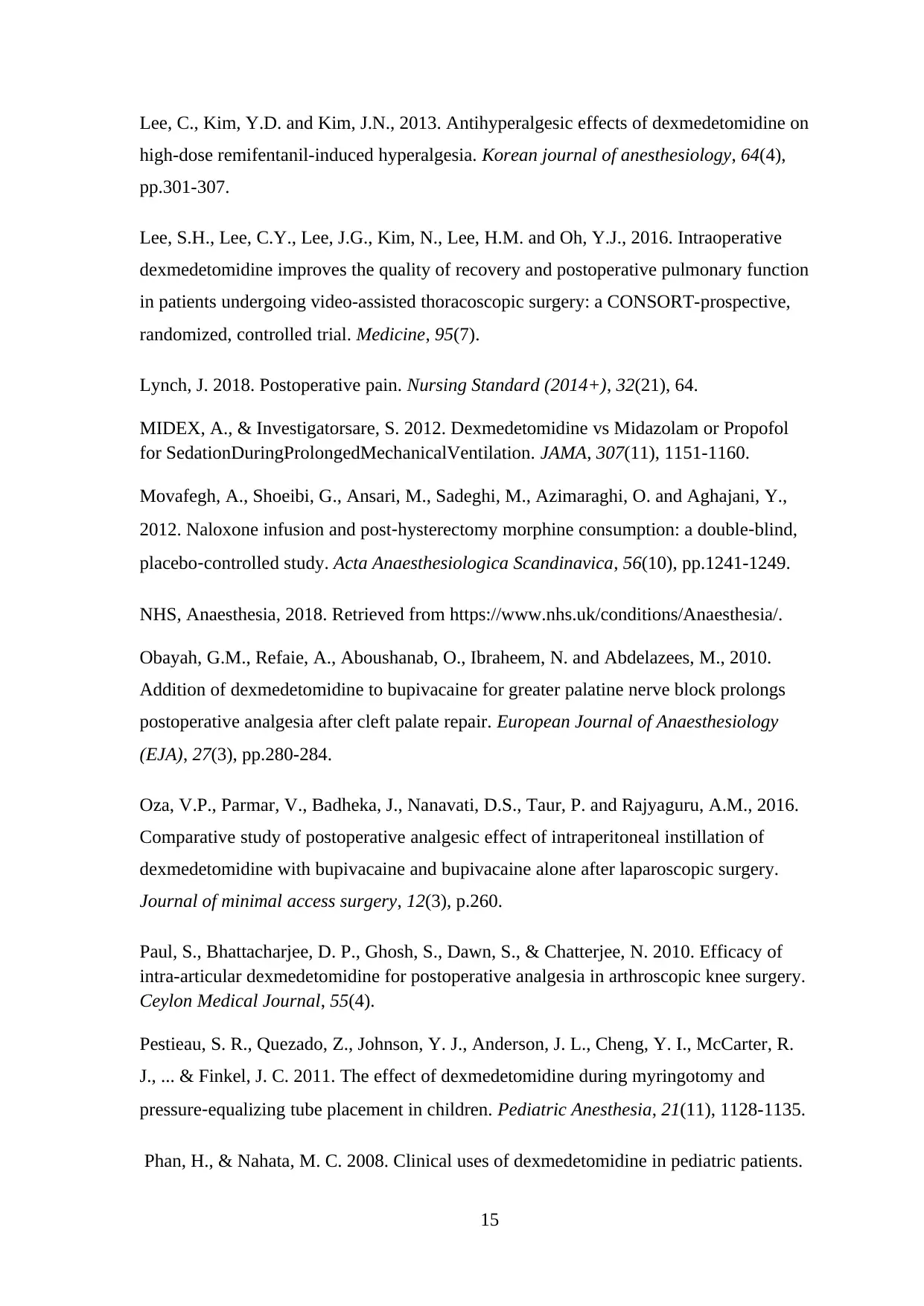
Lee, C., Kim, Y.D. and Kim, J.N., 2013. Antihyperalgesic effects of dexmedetomidine on
high-dose remifentanil-induced hyperalgesia. Korean journal of anesthesiology, 64(4),
pp.301-307.
Lee, S.H., Lee, C.Y., Lee, J.G., Kim, N., Lee, H.M. and Oh, Y.J., 2016. Intraoperative
dexmedetomidine improves the quality of recovery and postoperative pulmonary function
in patients undergoing video-assisted thoracoscopic surgery: a CONSORT-prospective,
randomized, controlled trial. Medicine, 95(7).
Lynch, J. 2018. Postoperative pain. Nursing Standard (2014+), 32(21), 64.
MIDEX, A., & Investigatorsare, S. 2012. Dexmedetomidine vs Midazolam or Propofol
for SedationDuringProlongedMechanicalVentilation. JAMA, 307(11), 1151-1160.
Movafegh, A., Shoeibi, G., Ansari, M., Sadeghi, M., Azimaraghi, O. and Aghajani, Y.,
2012. Naloxone infusion and post‐hysterectomy morphine consumption: a double‐blind,
placebo‐controlled study. Acta Anaesthesiologica Scandinavica, 56(10), pp.1241-1249.
NHS, Anaesthesia, 2018. Retrieved from https://www.nhs.uk/conditions/Anaesthesia/.
Obayah, G.M., Refaie, A., Aboushanab, O., Ibraheem, N. and Abdelazees, M., 2010.
Addition of dexmedetomidine to bupivacaine for greater palatine nerve block prolongs
postoperative analgesia after cleft palate repair. European Journal of Anaesthesiology
(EJA), 27(3), pp.280-284.
Oza, V.P., Parmar, V., Badheka, J., Nanavati, D.S., Taur, P. and Rajyaguru, A.M., 2016.
Comparative study of postoperative analgesic effect of intraperitoneal instillation of
dexmedetomidine with bupivacaine and bupivacaine alone after laparoscopic surgery.
Journal of minimal access surgery, 12(3), p.260.
Paul, S., Bhattacharjee, D. P., Ghosh, S., Dawn, S., & Chatterjee, N. 2010. Efficacy of
intra-articular dexmedetomidine for postoperative analgesia in arthroscopic knee surgery.
Ceylon Medical Journal, 55(4).
Pestieau, S. R., Quezado, Z., Johnson, Y. J., Anderson, J. L., Cheng, Y. I., McCarter, R.
J., ... & Finkel, J. C. 2011. The effect of dexmedetomidine during myringotomy and
pressure‐equalizing tube placement in children. Pediatric Anesthesia, 21(11), 1128-1135.
Phan, H., & Nahata, M. C. 2008. Clinical uses of dexmedetomidine in pediatric patients.
15
high-dose remifentanil-induced hyperalgesia. Korean journal of anesthesiology, 64(4),
pp.301-307.
Lee, S.H., Lee, C.Y., Lee, J.G., Kim, N., Lee, H.M. and Oh, Y.J., 2016. Intraoperative
dexmedetomidine improves the quality of recovery and postoperative pulmonary function
in patients undergoing video-assisted thoracoscopic surgery: a CONSORT-prospective,
randomized, controlled trial. Medicine, 95(7).
Lynch, J. 2018. Postoperative pain. Nursing Standard (2014+), 32(21), 64.
MIDEX, A., & Investigatorsare, S. 2012. Dexmedetomidine vs Midazolam or Propofol
for SedationDuringProlongedMechanicalVentilation. JAMA, 307(11), 1151-1160.
Movafegh, A., Shoeibi, G., Ansari, M., Sadeghi, M., Azimaraghi, O. and Aghajani, Y.,
2012. Naloxone infusion and post‐hysterectomy morphine consumption: a double‐blind,
placebo‐controlled study. Acta Anaesthesiologica Scandinavica, 56(10), pp.1241-1249.
NHS, Anaesthesia, 2018. Retrieved from https://www.nhs.uk/conditions/Anaesthesia/.
Obayah, G.M., Refaie, A., Aboushanab, O., Ibraheem, N. and Abdelazees, M., 2010.
Addition of dexmedetomidine to bupivacaine for greater palatine nerve block prolongs
postoperative analgesia after cleft palate repair. European Journal of Anaesthesiology
(EJA), 27(3), pp.280-284.
Oza, V.P., Parmar, V., Badheka, J., Nanavati, D.S., Taur, P. and Rajyaguru, A.M., 2016.
Comparative study of postoperative analgesic effect of intraperitoneal instillation of
dexmedetomidine with bupivacaine and bupivacaine alone after laparoscopic surgery.
Journal of minimal access surgery, 12(3), p.260.
Paul, S., Bhattacharjee, D. P., Ghosh, S., Dawn, S., & Chatterjee, N. 2010. Efficacy of
intra-articular dexmedetomidine for postoperative analgesia in arthroscopic knee surgery.
Ceylon Medical Journal, 55(4).
Pestieau, S. R., Quezado, Z., Johnson, Y. J., Anderson, J. L., Cheng, Y. I., McCarter, R.
J., ... & Finkel, J. C. 2011. The effect of dexmedetomidine during myringotomy and
pressure‐equalizing tube placement in children. Pediatric Anesthesia, 21(11), 1128-1135.
Phan, H., & Nahata, M. C. 2008. Clinical uses of dexmedetomidine in pediatric patients.
15
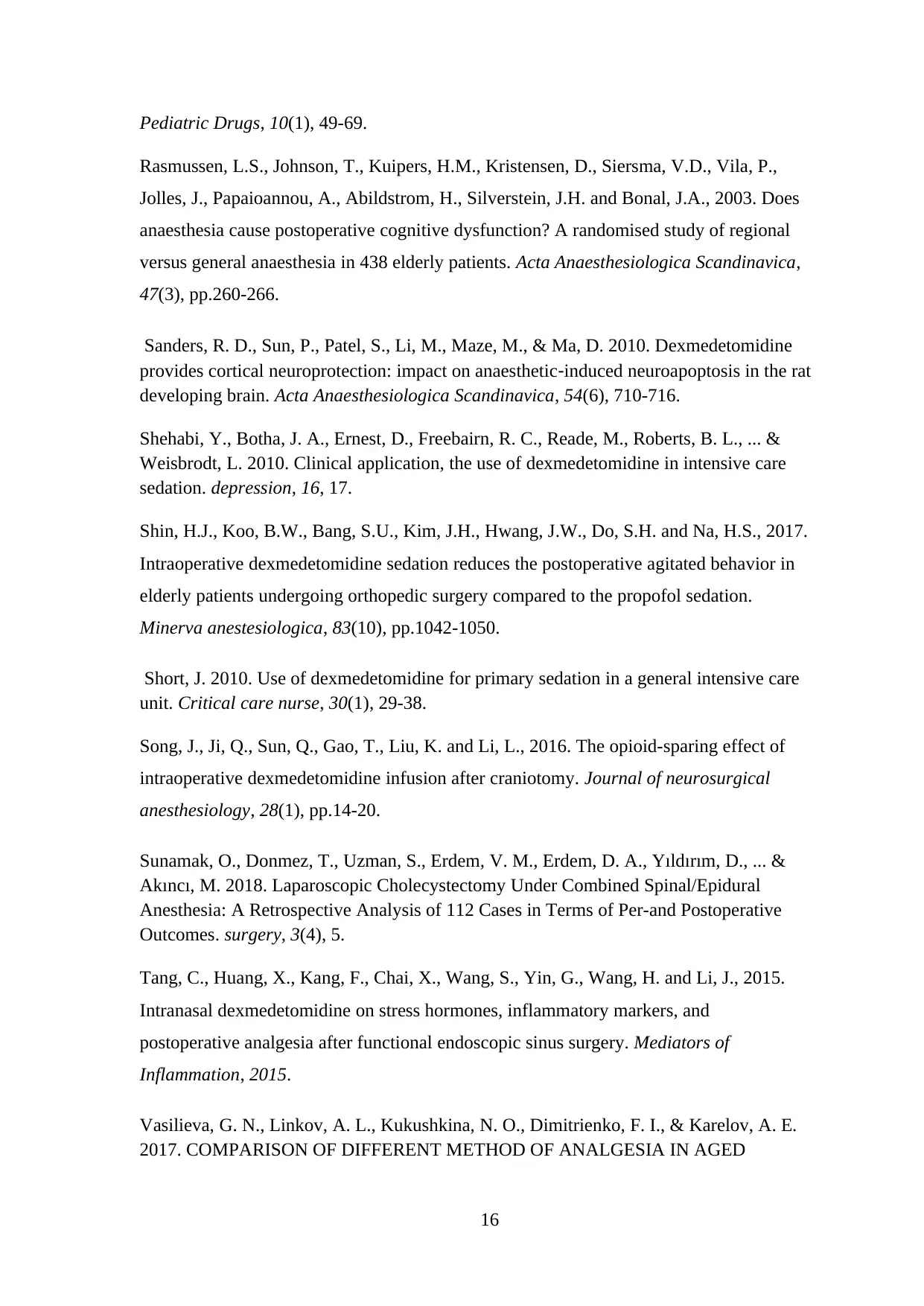
Pediatric Drugs, 10(1), 49-69.
Rasmussen, L.S., Johnson, T., Kuipers, H.M., Kristensen, D., Siersma, V.D., Vila, P.,
Jolles, J., Papaioannou, A., Abildstrom, H., Silverstein, J.H. and Bonal, J.A., 2003. Does
anaesthesia cause postoperative cognitive dysfunction? A randomised study of regional
versus general anaesthesia in 438 elderly patients. Acta Anaesthesiologica Scandinavica,
47(3), pp.260-266.
Sanders, R. D., Sun, P., Patel, S., Li, M., Maze, M., & Ma, D. 2010. Dexmedetomidine
provides cortical neuroprotection: impact on anaesthetic‐induced neuroapoptosis in the rat
developing brain. Acta Anaesthesiologica Scandinavica, 54(6), 710-716.
Shehabi, Y., Botha, J. A., Ernest, D., Freebairn, R. C., Reade, M., Roberts, B. L., ... &
Weisbrodt, L. 2010. Clinical application, the use of dexmedetomidine in intensive care
sedation. depression, 16, 17.
Shin, H.J., Koo, B.W., Bang, S.U., Kim, J.H., Hwang, J.W., Do, S.H. and Na, H.S., 2017.
Intraoperative dexmedetomidine sedation reduces the postoperative agitated behavior in
elderly patients undergoing orthopedic surgery compared to the propofol sedation.
Minerva anestesiologica, 83(10), pp.1042-1050.
Short, J. 2010. Use of dexmedetomidine for primary sedation in a general intensive care
unit. Critical care nurse, 30(1), 29-38.
Song, J., Ji, Q., Sun, Q., Gao, T., Liu, K. and Li, L., 2016. The opioid-sparing effect of
intraoperative dexmedetomidine infusion after craniotomy. Journal of neurosurgical
anesthesiology, 28(1), pp.14-20.
Sunamak, O., Donmez, T., Uzman, S., Erdem, V. M., Erdem, D. A., Yıldırım, D., ... &
Akıncı, M. 2018. Laparoscopic Cholecystectomy Under Combined Spinal/Epidural
Anesthesia: A Retrospective Analysis of 112 Cases in Terms of Per-and Postoperative
Outcomes. surgery, 3(4), 5.
Tang, C., Huang, X., Kang, F., Chai, X., Wang, S., Yin, G., Wang, H. and Li, J., 2015.
Intranasal dexmedetomidine on stress hormones, inflammatory markers, and
postoperative analgesia after functional endoscopic sinus surgery. Mediators of
Inflammation, 2015.
Vasilieva, G. N., Linkov, A. L., Kukushkina, N. O., Dimitrienko, F. I., & Karelov, A. E.
2017. COMPARISON OF DIFFERENT METHOD OF ANALGESIA IN AGED
16
Rasmussen, L.S., Johnson, T., Kuipers, H.M., Kristensen, D., Siersma, V.D., Vila, P.,
Jolles, J., Papaioannou, A., Abildstrom, H., Silverstein, J.H. and Bonal, J.A., 2003. Does
anaesthesia cause postoperative cognitive dysfunction? A randomised study of regional
versus general anaesthesia in 438 elderly patients. Acta Anaesthesiologica Scandinavica,
47(3), pp.260-266.
Sanders, R. D., Sun, P., Patel, S., Li, M., Maze, M., & Ma, D. 2010. Dexmedetomidine
provides cortical neuroprotection: impact on anaesthetic‐induced neuroapoptosis in the rat
developing brain. Acta Anaesthesiologica Scandinavica, 54(6), 710-716.
Shehabi, Y., Botha, J. A., Ernest, D., Freebairn, R. C., Reade, M., Roberts, B. L., ... &
Weisbrodt, L. 2010. Clinical application, the use of dexmedetomidine in intensive care
sedation. depression, 16, 17.
Shin, H.J., Koo, B.W., Bang, S.U., Kim, J.H., Hwang, J.W., Do, S.H. and Na, H.S., 2017.
Intraoperative dexmedetomidine sedation reduces the postoperative agitated behavior in
elderly patients undergoing orthopedic surgery compared to the propofol sedation.
Minerva anestesiologica, 83(10), pp.1042-1050.
Short, J. 2010. Use of dexmedetomidine for primary sedation in a general intensive care
unit. Critical care nurse, 30(1), 29-38.
Song, J., Ji, Q., Sun, Q., Gao, T., Liu, K. and Li, L., 2016. The opioid-sparing effect of
intraoperative dexmedetomidine infusion after craniotomy. Journal of neurosurgical
anesthesiology, 28(1), pp.14-20.
Sunamak, O., Donmez, T., Uzman, S., Erdem, V. M., Erdem, D. A., Yıldırım, D., ... &
Akıncı, M. 2018. Laparoscopic Cholecystectomy Under Combined Spinal/Epidural
Anesthesia: A Retrospective Analysis of 112 Cases in Terms of Per-and Postoperative
Outcomes. surgery, 3(4), 5.
Tang, C., Huang, X., Kang, F., Chai, X., Wang, S., Yin, G., Wang, H. and Li, J., 2015.
Intranasal dexmedetomidine on stress hormones, inflammatory markers, and
postoperative analgesia after functional endoscopic sinus surgery. Mediators of
Inflammation, 2015.
Vasilieva, G. N., Linkov, A. L., Kukushkina, N. O., Dimitrienko, F. I., & Karelov, A. E.
2017. COMPARISON OF DIFFERENT METHOD OF ANALGESIA IN AGED
16
Secure Best Marks with AI Grader
Need help grading? Try our AI Grader for instant feedback on your assignments.

PATIENTSWITH CHRONIC LOW BACK PAIN. HERALD of North-Western State
Medical University named after II Mechnikov, 9(4), 39-45.
Volkov, P.A., Churadze, B.T., Sevalkin, S.A., Volkova, Y.N. and Guryanov, V.A., 2015.
Dexmedetomidine as a part of analgesic component of general anesthesia for laparoscopic
operations. Anesteziologiia i reanimatologiia, 60(1), pp.4-8.
Wang, X., Wang, K., Wang, B., Jiang, T., Xu, Z., Wang, F. and Yu, J., 2016. Effect of
oxycodone combined with dexmedetomidine for intravenous patient-controlled analgesia
after video-assisted thoracoscopic lobectomy. Journal of cardiothoracic and vascular
anesthesia, 30(4), pp.1015-1021.
Xia, Z. Q., Chen, S. Q., Yao, X., Xie, C. B., Wen, S. H., & Liu, K. X. 2013. Clinical
benefits of dexmedetomidine versus propofol in adult intensive care unit patients: a meta-
analysis of randomized clinical trials. journal of surgical research, 185(2), 833-843.
Yoshitomi, T., Kohjitani, A., Maeda, S., Higuchi, H., Shimada, M., & Miyawaki, T.
2008. Dexmedetomidine enhances the local anesthetic action of lidocaine via an α-
2Aadrenoceptor. Anesthesia & Analgesia, 107(1), 96-101.
17
Medical University named after II Mechnikov, 9(4), 39-45.
Volkov, P.A., Churadze, B.T., Sevalkin, S.A., Volkova, Y.N. and Guryanov, V.A., 2015.
Dexmedetomidine as a part of analgesic component of general anesthesia for laparoscopic
operations. Anesteziologiia i reanimatologiia, 60(1), pp.4-8.
Wang, X., Wang, K., Wang, B., Jiang, T., Xu, Z., Wang, F. and Yu, J., 2016. Effect of
oxycodone combined with dexmedetomidine for intravenous patient-controlled analgesia
after video-assisted thoracoscopic lobectomy. Journal of cardiothoracic and vascular
anesthesia, 30(4), pp.1015-1021.
Xia, Z. Q., Chen, S. Q., Yao, X., Xie, C. B., Wen, S. H., & Liu, K. X. 2013. Clinical
benefits of dexmedetomidine versus propofol in adult intensive care unit patients: a meta-
analysis of randomized clinical trials. journal of surgical research, 185(2), 833-843.
Yoshitomi, T., Kohjitani, A., Maeda, S., Higuchi, H., Shimada, M., & Miyawaki, T.
2008. Dexmedetomidine enhances the local anesthetic action of lidocaine via an α-
2Aadrenoceptor. Anesthesia & Analgesia, 107(1), 96-101.
17
1 out of 17
Related Documents
Your All-in-One AI-Powered Toolkit for Academic Success.
+13062052269
info@desklib.com
Available 24*7 on WhatsApp / Email
![[object Object]](/_next/static/media/star-bottom.7253800d.svg)
Unlock your academic potential
© 2024 | Zucol Services PVT LTD | All rights reserved.





